Paul van Yperen's Blog, page 162
May 1, 2021
Sin City (2005)
Sin City (2005), also known as Frank Miller's Sin City, is an American Neo-Noir film produced and directed by Frank Miller and Robert Rodriguez, with Quentin Tarantino as "special guest director". The live-action film is based on Frank Miller's graphic novel series of the same name that won the Eisner Award.
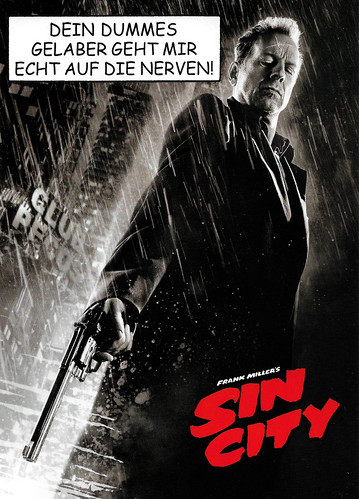
German postcard by Edgar Medien AG, no. 7.687. Image: Buena Vista / Miramax. Bruce Willis in Sin City (Frank Miller, Quentin Tarantino (special guest director), Robert Rodriguez, 2005). Caption: Your stupid talk really gets on my nerves!
The ultimate town without pity
Interweaving multiple storylines from the series' history, Sin City (2005) paints the picture of the ultimate town without pity through the eyes of its roughest characters.
Much of this violent Neo-Noir is based on the first, third, and fourth books in creator Frank Miller's original comic series.
'The Hard Goodbye' is about ex-convict Marv (Mickey Rourke) who embarks on a rampage in search of his one-time sweetheart's killer.
'The Big Fat Kill' follows photographer Dwight (Clive Owen), who gets caught in a street war between a group of prostitutes and a group of mercenaries, the police, and the mob.
'That Yellow Bastard' focuses on an aging police officer (Bruce Willis) who protects a young woman (Jessica Alba) from a grotesquely disfigured serial killer.
The intro and outro of the film are based on the short story 'The Customer is Always Right' which is collected in 'Booze, Broads & Bullets', the sixth book in the comic series.
Three directors received credit for Sin City: Frank Miller, Roberto Rodriguez, and Quentin Tarantino, the last for directing the drive-to-the-pits scene in which Dwight talks with a dead Jack Rafferty (Benicio del Toro). Miller and Rodriguez worked as a team directing the rest of the film.
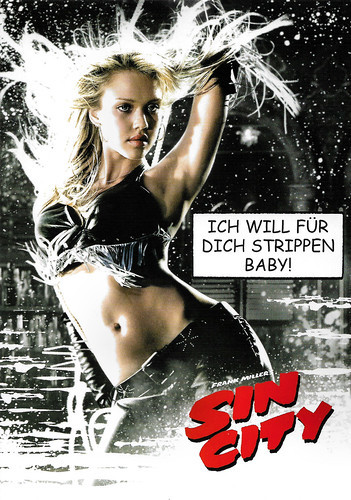
German postcard by Edgar Medien AG, no. 7.688. Image: Buena Vista / Miramax. Jessica Alba in Sin City (Frank Miller, Quentin Tarantino (special guest director), Robert Rodriguez, 2005). Caption: I wanna strip for you baby!
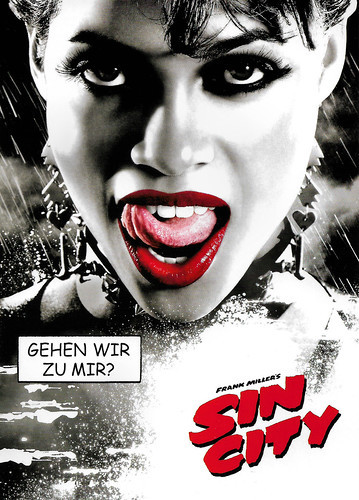
German postcard by Edgar Medien AG, no. 6.689. Image: Buena Vista / Miramax. Rosario Dawson in Sin City (Frank Miller, Quentin Tarantino (special guest director), Robert Rodriguez, 2005). Caption: Shall we go to me?
Less of an adaptation than a translation
Sin City (2005) stars an ensemble cast led by Jessica Alba, Benicio del Toro, Brittany Murphy, Clive Owen, Mickey Rourke, Bruce Willis, and Elijah Wood.
The film features Alexis Bledel, Michael Clarke Duncan, Rosario Dawson, Carla Gugino, Rutger Hauer , Jaime King, Michael Madsen, Nick Stahl, and Makenzie Vega among others.
Several of the scenes were shot before any actor had signed on; as a result, several stand-ins were used before the actual actors were digitally added into the film during post-production.
Rodriguez, an aficionado of cinematic technology, has used similar techniques in the past. The film was noted throughout production for Rodriguez's plan to stay faithful to the source material, unlike most other comic book adaptations.
Rodriguez stated that he considered the film to be "less of an adaptation than a translation". As a result, there is no screenwriting in the credits; simply "Based on the graphic novels by Frank Miller".
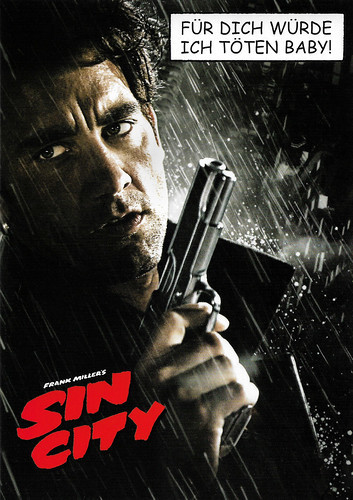
German postcard by Edgar Medien AG, no. 7.690. Image: Buena Vista / Miramax. Clive Owen in Sin City (Frank Miller, Quentin Tarantino (special guest director), Robert Rodriguez, 2005). Caption: For you, I will kill, baby!
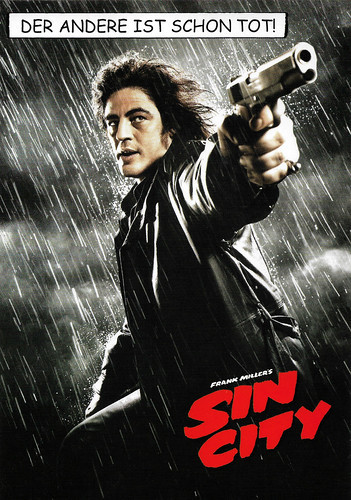
German postcard by Edgar Medien AG, no. 7.692. Image: Buena Vista / Miramax. Benicio Del Toro in Sin City (Frank Miller, Quentin Tarantino (special guest director), Robert Rodriguez, 2005). Caption: The other one is already dead!
A visualization of the pulp noir imagination, uncompromising and extreme
Sin City (2005) opened to wide critical and commercial success, gathering particular recognition for the film's unique color processing which rendered most of the film in black and white while retaining or adding color for selected objects.
The film was screened at the 2005 Cannes Film Festival in competition and won the Technical Grand Prize for the film's "visual shaping".
Jeremy Wheeler at AllMovie : "As far as comic adaptations go, Sin City is an unprecedented book-to-screen translation that's locked, loaded, and rip-roaring ready to introduce movie audiences to the mad genius that is Frank Miller."
Roger Ebert awarded the film 4/4 stars, describing it as "a visualization of the pulp noir imagination, uncompromising and extreme. Yes, and brilliant" and "This isn't an adaptation of a comic book, it's like a comic book brought to life and pumped with steroids. It contains characters who occupy stories, but to describe the characters and summarize the stories would be like replacing the weather with a weather map."
The New York Times critic Manohla Dargis gave credit for Rodriguez's "scrupulous care and obvious love for its genre influences", but noted that "it's a shame the movie is kind of a bore" because the director's vision seems to prevail on the intensity of reading a graphic novel.
Sin City grossed $29.1 million on its opening weekend, defeating fellow opener Beauty Shop by more than twice its opening take. The film saw a sharp decline in its second weekend, dropping over 50%. Ultimately, the film ended its North American run with a gross of $74.1 million against its $40 million negative cost. Overseas, the film grossed $84.6 million, for a worldwide total from theater receipts of $158.7 million.
A sequel, Sin City: A Dame to Kill For, was released in 2014, also directed by Miller and Rodriguez. It was a critical and financial failure.
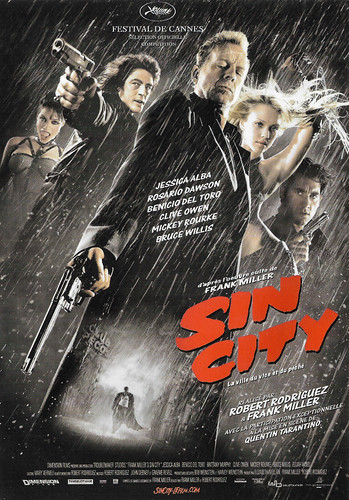
French postcard. Image: Miramax. Photos: Rico Torres. French poster for Sin City (Frank Miller, Quentin Tarantino (special guest director), Robert Rodriguez, 2005).
Sources: Roger Ebert, Jeremy Wheeler (AllMovie), Wikipedia, and IMDb.

German postcard by Edgar Medien AG, no. 7.687. Image: Buena Vista / Miramax. Bruce Willis in Sin City (Frank Miller, Quentin Tarantino (special guest director), Robert Rodriguez, 2005). Caption: Your stupid talk really gets on my nerves!
The ultimate town without pity
Interweaving multiple storylines from the series' history, Sin City (2005) paints the picture of the ultimate town without pity through the eyes of its roughest characters.
Much of this violent Neo-Noir is based on the first, third, and fourth books in creator Frank Miller's original comic series.
'The Hard Goodbye' is about ex-convict Marv (Mickey Rourke) who embarks on a rampage in search of his one-time sweetheart's killer.
'The Big Fat Kill' follows photographer Dwight (Clive Owen), who gets caught in a street war between a group of prostitutes and a group of mercenaries, the police, and the mob.
'That Yellow Bastard' focuses on an aging police officer (Bruce Willis) who protects a young woman (Jessica Alba) from a grotesquely disfigured serial killer.
The intro and outro of the film are based on the short story 'The Customer is Always Right' which is collected in 'Booze, Broads & Bullets', the sixth book in the comic series.
Three directors received credit for Sin City: Frank Miller, Roberto Rodriguez, and Quentin Tarantino, the last for directing the drive-to-the-pits scene in which Dwight talks with a dead Jack Rafferty (Benicio del Toro). Miller and Rodriguez worked as a team directing the rest of the film.

German postcard by Edgar Medien AG, no. 7.688. Image: Buena Vista / Miramax. Jessica Alba in Sin City (Frank Miller, Quentin Tarantino (special guest director), Robert Rodriguez, 2005). Caption: I wanna strip for you baby!

German postcard by Edgar Medien AG, no. 6.689. Image: Buena Vista / Miramax. Rosario Dawson in Sin City (Frank Miller, Quentin Tarantino (special guest director), Robert Rodriguez, 2005). Caption: Shall we go to me?
Less of an adaptation than a translation
Sin City (2005) stars an ensemble cast led by Jessica Alba, Benicio del Toro, Brittany Murphy, Clive Owen, Mickey Rourke, Bruce Willis, and Elijah Wood.
The film features Alexis Bledel, Michael Clarke Duncan, Rosario Dawson, Carla Gugino, Rutger Hauer , Jaime King, Michael Madsen, Nick Stahl, and Makenzie Vega among others.
Several of the scenes were shot before any actor had signed on; as a result, several stand-ins were used before the actual actors were digitally added into the film during post-production.
Rodriguez, an aficionado of cinematic technology, has used similar techniques in the past. The film was noted throughout production for Rodriguez's plan to stay faithful to the source material, unlike most other comic book adaptations.
Rodriguez stated that he considered the film to be "less of an adaptation than a translation". As a result, there is no screenwriting in the credits; simply "Based on the graphic novels by Frank Miller".

German postcard by Edgar Medien AG, no. 7.690. Image: Buena Vista / Miramax. Clive Owen in Sin City (Frank Miller, Quentin Tarantino (special guest director), Robert Rodriguez, 2005). Caption: For you, I will kill, baby!

German postcard by Edgar Medien AG, no. 7.692. Image: Buena Vista / Miramax. Benicio Del Toro in Sin City (Frank Miller, Quentin Tarantino (special guest director), Robert Rodriguez, 2005). Caption: The other one is already dead!
A visualization of the pulp noir imagination, uncompromising and extreme
Sin City (2005) opened to wide critical and commercial success, gathering particular recognition for the film's unique color processing which rendered most of the film in black and white while retaining or adding color for selected objects.
The film was screened at the 2005 Cannes Film Festival in competition and won the Technical Grand Prize for the film's "visual shaping".
Jeremy Wheeler at AllMovie : "As far as comic adaptations go, Sin City is an unprecedented book-to-screen translation that's locked, loaded, and rip-roaring ready to introduce movie audiences to the mad genius that is Frank Miller."
Roger Ebert awarded the film 4/4 stars, describing it as "a visualization of the pulp noir imagination, uncompromising and extreme. Yes, and brilliant" and "This isn't an adaptation of a comic book, it's like a comic book brought to life and pumped with steroids. It contains characters who occupy stories, but to describe the characters and summarize the stories would be like replacing the weather with a weather map."
The New York Times critic Manohla Dargis gave credit for Rodriguez's "scrupulous care and obvious love for its genre influences", but noted that "it's a shame the movie is kind of a bore" because the director's vision seems to prevail on the intensity of reading a graphic novel.
Sin City grossed $29.1 million on its opening weekend, defeating fellow opener Beauty Shop by more than twice its opening take. The film saw a sharp decline in its second weekend, dropping over 50%. Ultimately, the film ended its North American run with a gross of $74.1 million against its $40 million negative cost. Overseas, the film grossed $84.6 million, for a worldwide total from theater receipts of $158.7 million.
A sequel, Sin City: A Dame to Kill For, was released in 2014, also directed by Miller and Rodriguez. It was a critical and financial failure.

French postcard. Image: Miramax. Photos: Rico Torres. French poster for Sin City (Frank Miller, Quentin Tarantino (special guest director), Robert Rodriguez, 2005).
Sources: Roger Ebert, Jeremy Wheeler (AllMovie), Wikipedia, and IMDb.
Published on May 01, 2021 22:00
April 30, 2021
The Pictures Portrait Gallery: the Men
During the 1910s and 1920s, Pictures Ltd. in London published the Pictures Portrait Gallery series as a supplement for their magazine 'Pictures' which from 1920 on was named 'Pictures for the Picturegoer'. Many Hollywood stars but also British actors were highlighted in this series. Today, we publish 15 male stars of the silent cinema of this British series. Next week a post with 15 legendary ladies of the screen will follow.
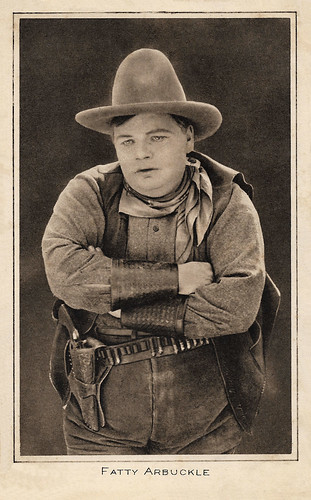
Roscoe ‘Fatty’ Arbuckle . British postcard in the Pictures Portrait Gallery series by Pictures Ltd., London, no. 9/192.
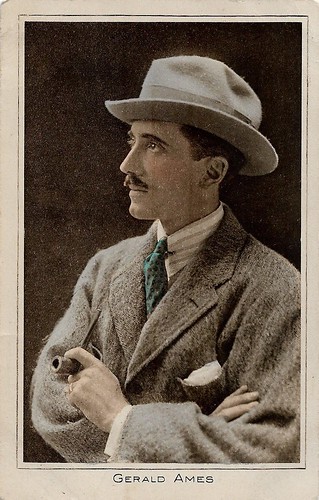
Gerald Ames . British postcard in the Pictures Portrait Gallery series by Pictures Ltd., London, no.18.
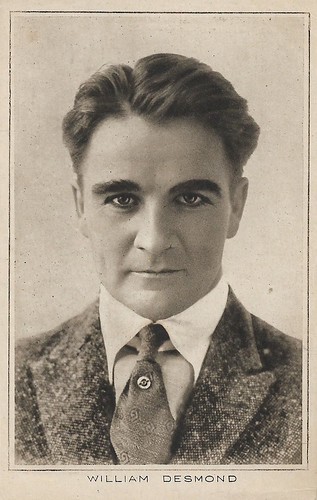
William Desmond . British postcard in the Pictures Portrait Gallery series by Pictures Ltd., London, no. 22.
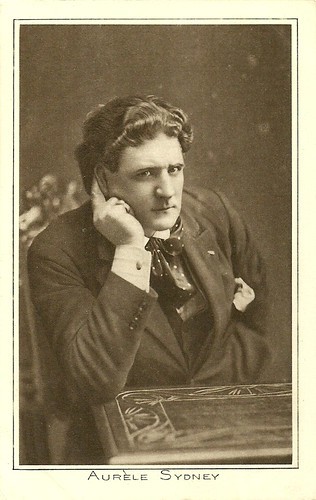
Aurele Sydney . British postcard in the Pictures Portrait Gallery series by Pictures Ltd., London, no. 43.
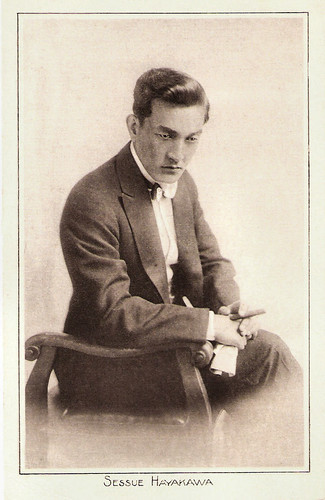
Sessue Hayakawa . British postcard in the Pictures Portrait Gallery series by Pictures Ltd., London, no. 45.
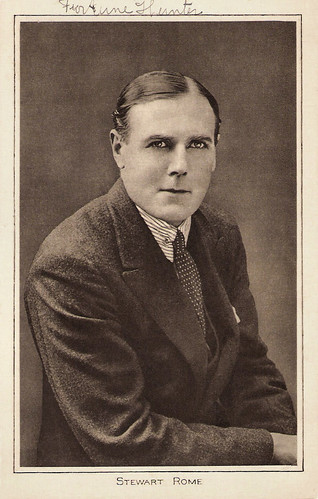
Stewart Rome . British postcard in the Pictures Portrait Gallery series by Pictures Ltd., London, no. 59. Photo: Broadwest Films Ltd.
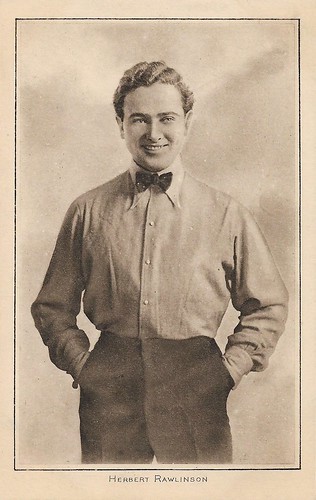
Herbert Rawlinson . British postcard in the 'Pictures' Portrait Gallery by Pictures Ltd., London, no. 82.
Pictures and Picturegoers
In October 1913, Picturegoer the Picture Theatre Magazine was founded in London. After 19 issues, the 21 February 1914 issue was re-titled as no.1 of Pictures AND The Picturegoer.
In 1918 the publisher, Publisher Ltd., started issuing sepia printed photogravure postcards entitled 'The Pictures Portrait Gallery'. All 101 are addressed 85 Long Acre London, but cards 1–42 were printed in black, cards 43-101 in brown.
The Editor of Pictures and the Picturegoer was Fred Dangerfield and the Secretary and Postcard Manager was G. Southwood. Both were pictured on two postcards of the series, photographed by Elwin Neame, father of British film director Ronald Neame.
On 27 November 1920, issue no. 354 of the magazine was retitled 'Pictures FOR The Picturegoer'. The Pictures Portrait Gallery series continued, but citing 88 Long Acre in London as the publisher's address on the reverse.
Card 11/224 is so far the highest number found in the Pictures Portrait Gallery series. The highest number card so far found is 238 (Corinne Griffith), which seems a rather odd number to stop on. In 1922 Pictures for the Picturegoer changed its name to PICTURES: The Screen Magazine but only a few months later it had been subsumed by Picturegoer magazine.
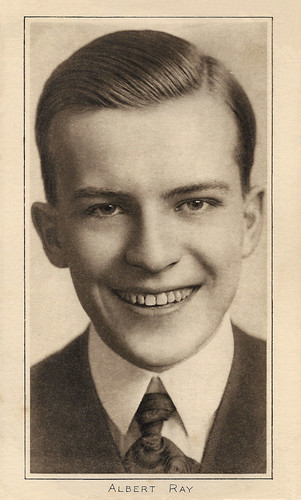
Albert Ray. British postcard in the 'Pictures' Portrait Gallery by Pictures Ltd., London, no. 101. Photo: The Fox Film Co.
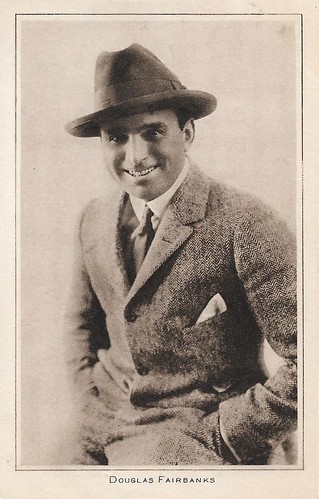
Douglas Fairbanks . British postcard in the 'Pictures' Portrait Gallery by Pictures Ltd., London, no. 107.
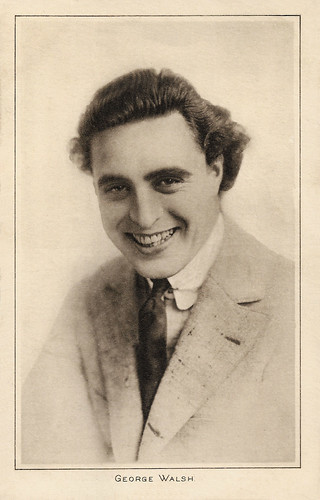
George Walsh . British postcard in the 'Pictures' Portrait Gallery by Pictures Ltd., London, no. 113.
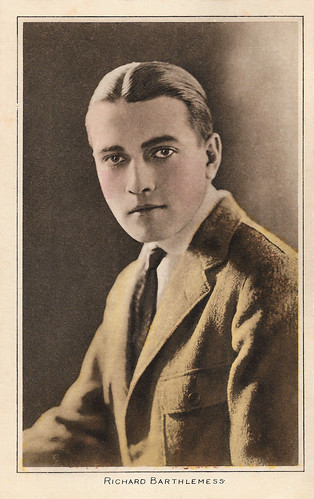
Richard Barthelmess . British postcard in the 'Pictures' Portrait Gallery by Pictures Ltd., London, no. 122. Barthelmess is misspelled as Barthlemess.
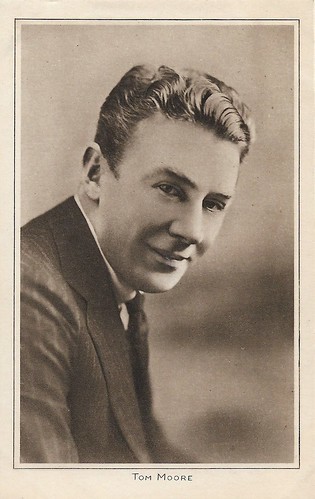
Tom Moore . British postcard in the 'Pictures' Portrait Gallery by Pictures Ltd., London, no. 124.
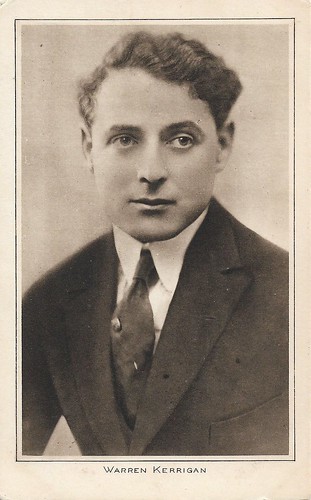
J. (Jack) Warren Kerrigan. British postcard in the 'Pictures' Portrait Gallery by Pictures Ltd., London, no. 137.
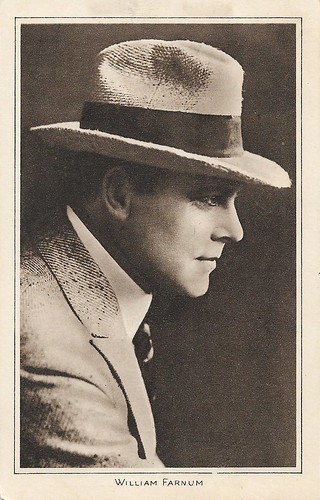
William Farnum . British postcard in the 'Pictures' Portrait Gallery by Pictures Ltd., London.
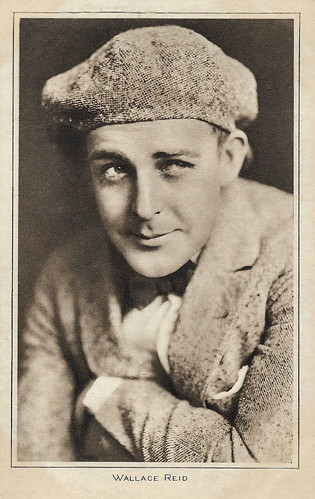
Wallace Reid . British postcard by 'Pictures' Portrait Gallery, London, by Pictures Ltd. London, no. 145.
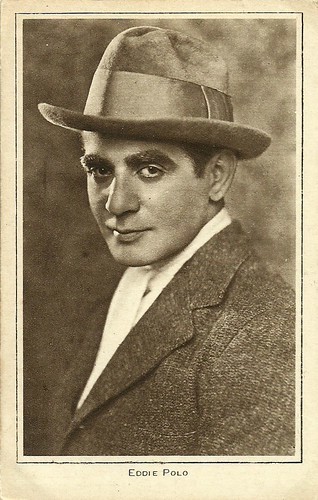
Eddie Polo . British postcard by 'Pictures' Portrait Gallery, London, by Pictures Ltd. London, no. 155.
Source: Our Cinema Postcards.

Roscoe ‘Fatty’ Arbuckle . British postcard in the Pictures Portrait Gallery series by Pictures Ltd., London, no. 9/192.

Gerald Ames . British postcard in the Pictures Portrait Gallery series by Pictures Ltd., London, no.18.

William Desmond . British postcard in the Pictures Portrait Gallery series by Pictures Ltd., London, no. 22.

Aurele Sydney . British postcard in the Pictures Portrait Gallery series by Pictures Ltd., London, no. 43.

Sessue Hayakawa . British postcard in the Pictures Portrait Gallery series by Pictures Ltd., London, no. 45.

Stewart Rome . British postcard in the Pictures Portrait Gallery series by Pictures Ltd., London, no. 59. Photo: Broadwest Films Ltd.

Herbert Rawlinson . British postcard in the 'Pictures' Portrait Gallery by Pictures Ltd., London, no. 82.
Pictures and Picturegoers
In October 1913, Picturegoer the Picture Theatre Magazine was founded in London. After 19 issues, the 21 February 1914 issue was re-titled as no.1 of Pictures AND The Picturegoer.
In 1918 the publisher, Publisher Ltd., started issuing sepia printed photogravure postcards entitled 'The Pictures Portrait Gallery'. All 101 are addressed 85 Long Acre London, but cards 1–42 were printed in black, cards 43-101 in brown.
The Editor of Pictures and the Picturegoer was Fred Dangerfield and the Secretary and Postcard Manager was G. Southwood. Both were pictured on two postcards of the series, photographed by Elwin Neame, father of British film director Ronald Neame.
On 27 November 1920, issue no. 354 of the magazine was retitled 'Pictures FOR The Picturegoer'. The Pictures Portrait Gallery series continued, but citing 88 Long Acre in London as the publisher's address on the reverse.
Card 11/224 is so far the highest number found in the Pictures Portrait Gallery series. The highest number card so far found is 238 (Corinne Griffith), which seems a rather odd number to stop on. In 1922 Pictures for the Picturegoer changed its name to PICTURES: The Screen Magazine but only a few months later it had been subsumed by Picturegoer magazine.

Albert Ray. British postcard in the 'Pictures' Portrait Gallery by Pictures Ltd., London, no. 101. Photo: The Fox Film Co.

Douglas Fairbanks . British postcard in the 'Pictures' Portrait Gallery by Pictures Ltd., London, no. 107.

George Walsh . British postcard in the 'Pictures' Portrait Gallery by Pictures Ltd., London, no. 113.

Richard Barthelmess . British postcard in the 'Pictures' Portrait Gallery by Pictures Ltd., London, no. 122. Barthelmess is misspelled as Barthlemess.

Tom Moore . British postcard in the 'Pictures' Portrait Gallery by Pictures Ltd., London, no. 124.

J. (Jack) Warren Kerrigan. British postcard in the 'Pictures' Portrait Gallery by Pictures Ltd., London, no. 137.

William Farnum . British postcard in the 'Pictures' Portrait Gallery by Pictures Ltd., London.

Wallace Reid . British postcard by 'Pictures' Portrait Gallery, London, by Pictures Ltd. London, no. 145.

Eddie Polo . British postcard by 'Pictures' Portrait Gallery, London, by Pictures Ltd. London, no. 155.
Source: Our Cinema Postcards.
Published on April 30, 2021 22:00
April 29, 2021
Kevin Costner
Kevin Costner (1955) is one of Hollywood's most prominent strong, silent types. He had his breakthrough with his portrayal of Eliot Ness in The Untouchables (1987). For several years he was the celluloid personification of the baseball industry, given his indelible mark with baseball-themed hits like Bull Durham (1988), Field of Dreams (1989), and For Love of the Game. His epic Western Dances with Wolves (1990) marked the first break from this trend and established Costner as a formidable directing talent to boot. He received two Oscars, two Golden Globes, and a Primetime Emmy. Although several flops in the late 1990s diminished his bankability, for many, Costner remained one of the industry's most enduring and endearing icons.
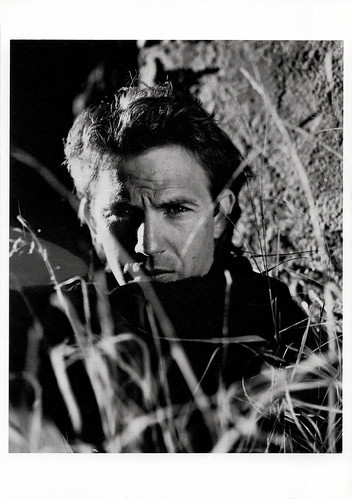
American postcard by Fotofolio, New York, no. GG13. Photo: Greg Gorman. Caption: Kevin Costner, Santa Barbara, 1988.
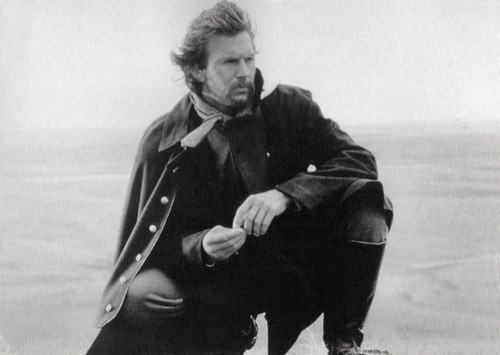
French postcard, no. 2056. Kevin Costner in Dances with Wolves (Kevin Costner, 1990).
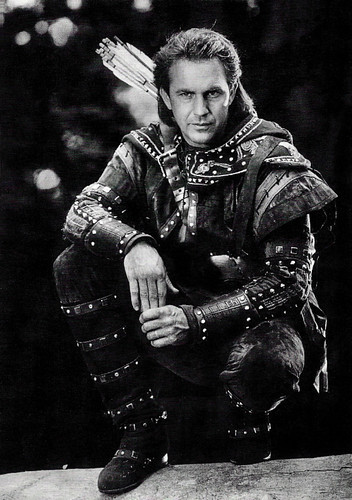
Vintage postcard, no. 2036. Kevin Costner in Robin Hood - Prince of Thieves (Kevin Reynolds, 1991).
The first Western epic that Hollywood had seen in years
Kevin Costner was born in 1955, in Lynwood, California, and grew up in Compton. His mother, Sharon Rae (Tedrick), was a welfare worker, and his father, William Costner, was an electrician and, later, a utility executive at Southern California Edison.
Kevin was not academically inclined in school. He enjoyed sports (especially football), took piano lessons, wrote poetry, and sang in the First Baptist Choir. While a marketing student at California State University in Fullerton, he became involved with community theatre. Upon graduation in 1978, he married Cindy Silva, who worked at Disneyland as Cinderella. Costner took a marketing job that lasted all of 30 days before he decided to take a crack at acting.
He took work that allowed him to develop his acting skills via tuition, including working on fishing boats, as a truck driver, and giving tours of stars' Hollywood homes to support the couple while he also attended auditions. He made an inauspicious film debut in the ultra-cheap independent film Sizzle Beach USA/Hot Malibu Summer (Richard Brander, 1986). AllMovie mentions 1974 as the premiere date. According to Wikipedia , it was filmed in the winter of 1978–1979, but the film was not released until 1981 and re-released in 1986 after Costner became a celebrity.
However, Costner decided to take a more serious approach to acting. Venturing down the usual theatre-workshop, multiple-audition route, the actor impressed casting directors who weren't really certain of how to use him. That may be one reason why Costner's big-studio debut in Night Shift (Ron Howard, 1982) consisted of little more than background decoration, and the same year's Frances (Graeme Clifford, 1982) starring Jessica Lange, featured the hapless young actor as an off-stage voice.
Director Lawrence Kasdan liked Costner enough to cast him in the important role of the suicide victim who motivated the plot of The Big Chill (Lawrence Kasdan, 1983). Unfortunately, his flashback scenes were edited out of the film, leaving all that was visible of the actor - who had turned down Matthew Broderick's role in WarGames (John Badham, 1983) to take the part - to be his dress suit, along with a fleeting glimpse of his hairline and hands as the undertaker prepared him for burial during the opening credits.
Two years later, a guilt-ridden Kasdan chose Costner for a major part as a hell-raising gunfighter in the 'retro' Western Silverado (Lawrence Kasdan, 1985), this time putting him in front of the camera for virtually the entire film. He also gained notice for the Diner-ish buddy road movie Fandango (Kevin Reynolds, 1985).
The actor's big break came two years later as he burst onto the screen in two major films, No Way Out (Roger Donaldson, 1987) and The Untouchables (Brian De Palma, 1987); his growing popularity was further amplified with a brace of baseball films, released within months of one another. In Bull Durham (Ron Shelton, 1988), the actor was taciturn minor-league ballplayer Crash Davis, and in the following year's Field of Dreams (Phil Alden Robinson, 1989), he was Ray Kinsella, a farmer who constructs a baseball diamond in his Iowa cornfield at the repeated urging of a voice that intones "if you build it, he will come."
Riding high on the combined box-office success of these films, Costner was able to make his directing debut. With a small budget of 18 million dollars, he went off to the Black Hills of South Dakota to film the first Western epic that Hollywood had seen in years, a revisionist look at American Indian-white relationships titled Dances With Wolves (Kevin Costner, 1990). The supposedly doomed project, in addition to being one of 1990's biggest moneymakers, also took home a slew of Academy Awards, including statues for Best Picture and Best Director.
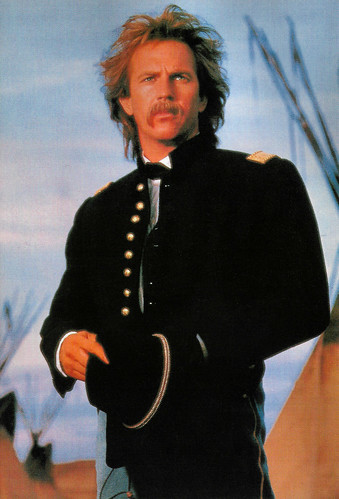
French postcard, no. A088. Kevin Costner in Dances with Wolves (Kevin Costner, 1990).
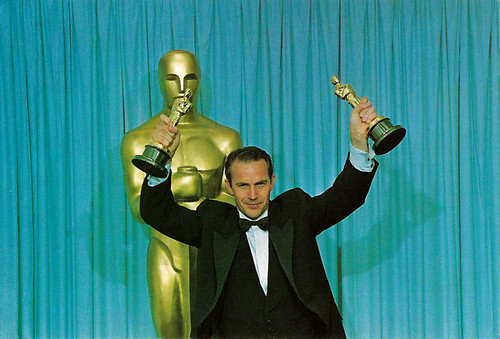
French postcard, no. A083. Sent by mail in 1994. Kevin Costner winning two Oscars for Dances with Wolves (Kevin Costner, 1990).
A whopping amount of negative publicity
Kevin Costner's luck continued with the costume epic Robin Hood: Prince of Thieves (Kevin Reynolds, 1991). The film made money, though it seriously strained Costner's longtime friendship with director Reynolds. The same year, Costner had another hit - and critical success - on his hands with JFK (Oliver Stone, 1991). It examines the events leading to the assassination of United States President John F. Kennedy and alleged cover-up through the eyes of former New Orleans district attorney Jim Garrison (Costner).
The next year's The Bodyguard (Mick Jackson, 1992), a romantic thriller written by Lawrence Kasdan, teamed Costner with Whitney Houston in her film debut. It follows a former Secret Service agent turned bodyguard who is hired to protect a music superstar from an unknown stalker. The film did so well at the box office that it seemed the actor could do no wrong.
However, his next film, A Perfect World (Clint Eastwood, 1993), casting Costner against type as a half-psycho, half-benign prison escapee, was a major disappointment, even though Costner himself garnered some acclaim. Bad luck followed Perfect World in the form of another cast-against-type failure, the Western Wyatt Earp (Lawrence Kasdan, 1994).
Hal Erickson at AllMovie : "Adding insult to injury, Costner's 1995 epic sci-fi adventure Waterworld received a whopping amount of negative publicity prior to opening due to its ballooning budget and bloated schedule; ultimately, its decent box office total in no way offset its cost."
The following year, Costner was able to rebound somewhat with the romantic comedy Tin Cup (Ron Shelton, 1996), opposite Rene Russo, and with Cheech Marin and Don Johnson in major supporting roles. The film was well-received by the critics and the public alike, and Costner received a nomination for the Golden Globe Award for Best Actor.
Unfortunately, he opted to follow up this success with another large-scaled directorial effort, an epic adaptation of author David Brin's The Postman (Kevin Costner, 1997). It featured Costner as a Shakespeare-spouting drifter in a post-nuclear holocaust America whose efforts to reunite the country give him messianic qualities. Like Waterworld, The Postman received a critical drubbing and did poorly with audiences.
Costner's reputation, now at an all-time low, received some resuscitation with the romantic drama Message in a Bottle (Luis Mandoki, 1998), with Robin Wright, and later the same year he returned to the genre that loved him best with the baseball drama For Love of the Game (Sam Raimi, 1998). A thoughtful reflection on the Cuban missile crisis provided the groundwork for the mid-level success of the historical political thriller Thirteen Days (Roger Donaldson, 2000).
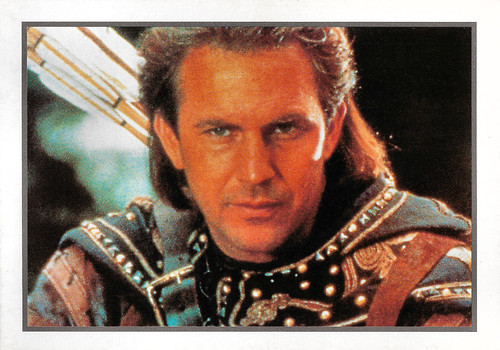
French postcard, no. 1023. Kevin Costner in Robin Hood - Prince of Thieves (Kevin Reynolds, 1991).
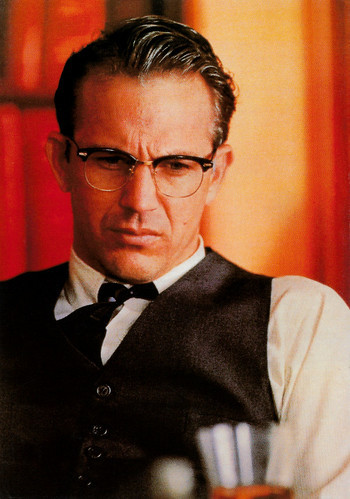
French postcard, no. 1308. Kevin Costner in JFK (Oliver Stone, 1991).
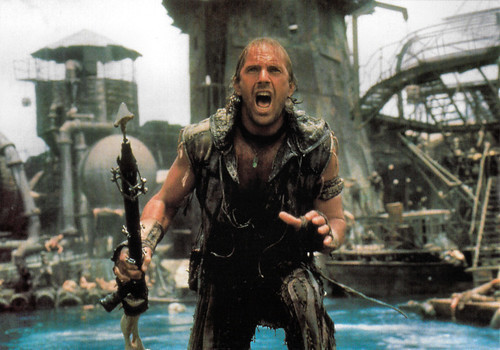
Dutch postcard by Boomerang. Photo: UIP. Kevin Costner in Waterworld (Kevin Costner, 1995). Caption: Beyond the horizon lies the secret to a new beginning.
Clark Kent's adoptive dad on Planet Earth
Kevin Costner's played a member of a group of Elvis impersonating casino bandits in 3000 Miles to Graceland (Demian Lichtenstein, 2001) with Kurt Russell. This film drew harsh criticism, relegating it to a quick death at the box office. Costner's next effort was a more sentimental supernatural drama lamenting lost love, Dragonfly (Tom Shadyac, 2002).
Hal Erickson at AllMovie : "Costner fared better in 2003, and returned to directing, with Open Range, a Western co-starring himself and the iconic Robert Duvall -- while it was no Dances With Wolves in terms of mainstream popularity, it certainly received more positive feedback than The Postman or Waterworld."
Next, Costner starred alongside Joan Allen in the drama The Upside of Anger (Mike Binder, 2004). It cast Allen as a single, upper-middle-class woman who unexpectedly strikes up a romance with the boozy ex-baseball star who lives next door (Costner). Even if divided on the picture as a whole, critics unanimously praised the lead performances by Costner and Allen.
After the thoroughly dispiriting quasi-sequel to The Graduate, Rumor Has It... (Rob Reiner, 2005), starring Jennifer Anniston, Costner teamed up with Fugitive director Andrew Davis for the moderately successful Coast Guard thriller The Guardian (Andrew Davies, 2006), co-starring Ashton Kutcher.
Costner then undertook another change-of-pace with one of his first psychological thrillers, Mr. Brooks, (Bruce A. Evans, 2007). Playing a psychotic criminal spurred on to macabre acts by his homicidal alter ego (William Hurt), Costner emerged from the critical- and box-office failure fairly unscathed.
He came back swinging the following year with a starring role in the comedy Swing Vote (Joshua Michael Stern, 2008), playing a small-town slacker whose single vote is about to determine the outcome of a presidential election. Costner's usual everyman charm carried the movie, but soon he was back to his more somber side, starring in the recession-era drama The Company Men (John Wells, 2010) alongside Ben Affleck, Chris Cooper, and Tommy Lee Jones.
As the 2010s rolled on, Costner's name appeared often in conjunction with the Quentin Tarantino film Django Unchained prior to filming, but scheduling conflicts would eventually prevent the actor from participating in the project. He instead signed on for the latest Superman reboot, playing Clark Kent's adoptive dad on Planet Earth in Man of Steel (Zack Snyder, 2013) starring Henry Cavill.
In 2020, Kevin Costner returned to form with Let Him Go (Thomas Bezucha, 2020) with Diane Lane. They played a retired sheriff and his wife, grieving over the death of their son, set out to find their only grandson.
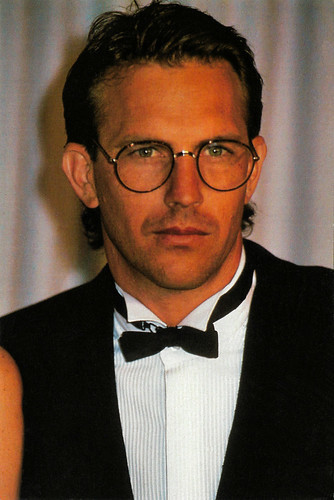
French postcard in the Postcard Collection, no. PC 115.
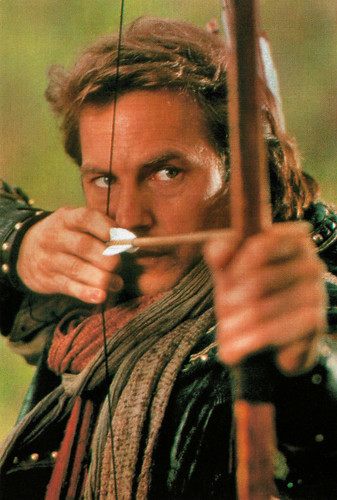
French postcard, no. A085. Kevin Costner in Robin Hood - Prince of Thieves (Kevin Reynolds, 1991).
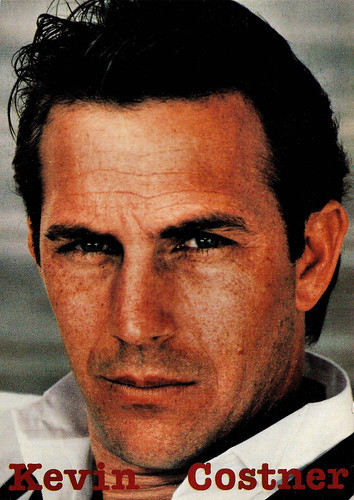
British postcard by Oliver Books Ltd, London, no. 103.
Sources: Hal Erickson (AllMovie), Wikipedia, and .

American postcard by Fotofolio, New York, no. GG13. Photo: Greg Gorman. Caption: Kevin Costner, Santa Barbara, 1988.

French postcard, no. 2056. Kevin Costner in Dances with Wolves (Kevin Costner, 1990).

Vintage postcard, no. 2036. Kevin Costner in Robin Hood - Prince of Thieves (Kevin Reynolds, 1991).
The first Western epic that Hollywood had seen in years
Kevin Costner was born in 1955, in Lynwood, California, and grew up in Compton. His mother, Sharon Rae (Tedrick), was a welfare worker, and his father, William Costner, was an electrician and, later, a utility executive at Southern California Edison.
Kevin was not academically inclined in school. He enjoyed sports (especially football), took piano lessons, wrote poetry, and sang in the First Baptist Choir. While a marketing student at California State University in Fullerton, he became involved with community theatre. Upon graduation in 1978, he married Cindy Silva, who worked at Disneyland as Cinderella. Costner took a marketing job that lasted all of 30 days before he decided to take a crack at acting.
He took work that allowed him to develop his acting skills via tuition, including working on fishing boats, as a truck driver, and giving tours of stars' Hollywood homes to support the couple while he also attended auditions. He made an inauspicious film debut in the ultra-cheap independent film Sizzle Beach USA/Hot Malibu Summer (Richard Brander, 1986). AllMovie mentions 1974 as the premiere date. According to Wikipedia , it was filmed in the winter of 1978–1979, but the film was not released until 1981 and re-released in 1986 after Costner became a celebrity.
However, Costner decided to take a more serious approach to acting. Venturing down the usual theatre-workshop, multiple-audition route, the actor impressed casting directors who weren't really certain of how to use him. That may be one reason why Costner's big-studio debut in Night Shift (Ron Howard, 1982) consisted of little more than background decoration, and the same year's Frances (Graeme Clifford, 1982) starring Jessica Lange, featured the hapless young actor as an off-stage voice.
Director Lawrence Kasdan liked Costner enough to cast him in the important role of the suicide victim who motivated the plot of The Big Chill (Lawrence Kasdan, 1983). Unfortunately, his flashback scenes were edited out of the film, leaving all that was visible of the actor - who had turned down Matthew Broderick's role in WarGames (John Badham, 1983) to take the part - to be his dress suit, along with a fleeting glimpse of his hairline and hands as the undertaker prepared him for burial during the opening credits.
Two years later, a guilt-ridden Kasdan chose Costner for a major part as a hell-raising gunfighter in the 'retro' Western Silverado (Lawrence Kasdan, 1985), this time putting him in front of the camera for virtually the entire film. He also gained notice for the Diner-ish buddy road movie Fandango (Kevin Reynolds, 1985).
The actor's big break came two years later as he burst onto the screen in two major films, No Way Out (Roger Donaldson, 1987) and The Untouchables (Brian De Palma, 1987); his growing popularity was further amplified with a brace of baseball films, released within months of one another. In Bull Durham (Ron Shelton, 1988), the actor was taciturn minor-league ballplayer Crash Davis, and in the following year's Field of Dreams (Phil Alden Robinson, 1989), he was Ray Kinsella, a farmer who constructs a baseball diamond in his Iowa cornfield at the repeated urging of a voice that intones "if you build it, he will come."
Riding high on the combined box-office success of these films, Costner was able to make his directing debut. With a small budget of 18 million dollars, he went off to the Black Hills of South Dakota to film the first Western epic that Hollywood had seen in years, a revisionist look at American Indian-white relationships titled Dances With Wolves (Kevin Costner, 1990). The supposedly doomed project, in addition to being one of 1990's biggest moneymakers, also took home a slew of Academy Awards, including statues for Best Picture and Best Director.

French postcard, no. A088. Kevin Costner in Dances with Wolves (Kevin Costner, 1990).

French postcard, no. A083. Sent by mail in 1994. Kevin Costner winning two Oscars for Dances with Wolves (Kevin Costner, 1990).
A whopping amount of negative publicity
Kevin Costner's luck continued with the costume epic Robin Hood: Prince of Thieves (Kevin Reynolds, 1991). The film made money, though it seriously strained Costner's longtime friendship with director Reynolds. The same year, Costner had another hit - and critical success - on his hands with JFK (Oliver Stone, 1991). It examines the events leading to the assassination of United States President John F. Kennedy and alleged cover-up through the eyes of former New Orleans district attorney Jim Garrison (Costner).
The next year's The Bodyguard (Mick Jackson, 1992), a romantic thriller written by Lawrence Kasdan, teamed Costner with Whitney Houston in her film debut. It follows a former Secret Service agent turned bodyguard who is hired to protect a music superstar from an unknown stalker. The film did so well at the box office that it seemed the actor could do no wrong.
However, his next film, A Perfect World (Clint Eastwood, 1993), casting Costner against type as a half-psycho, half-benign prison escapee, was a major disappointment, even though Costner himself garnered some acclaim. Bad luck followed Perfect World in the form of another cast-against-type failure, the Western Wyatt Earp (Lawrence Kasdan, 1994).
Hal Erickson at AllMovie : "Adding insult to injury, Costner's 1995 epic sci-fi adventure Waterworld received a whopping amount of negative publicity prior to opening due to its ballooning budget and bloated schedule; ultimately, its decent box office total in no way offset its cost."
The following year, Costner was able to rebound somewhat with the romantic comedy Tin Cup (Ron Shelton, 1996), opposite Rene Russo, and with Cheech Marin and Don Johnson in major supporting roles. The film was well-received by the critics and the public alike, and Costner received a nomination for the Golden Globe Award for Best Actor.
Unfortunately, he opted to follow up this success with another large-scaled directorial effort, an epic adaptation of author David Brin's The Postman (Kevin Costner, 1997). It featured Costner as a Shakespeare-spouting drifter in a post-nuclear holocaust America whose efforts to reunite the country give him messianic qualities. Like Waterworld, The Postman received a critical drubbing and did poorly with audiences.
Costner's reputation, now at an all-time low, received some resuscitation with the romantic drama Message in a Bottle (Luis Mandoki, 1998), with Robin Wright, and later the same year he returned to the genre that loved him best with the baseball drama For Love of the Game (Sam Raimi, 1998). A thoughtful reflection on the Cuban missile crisis provided the groundwork for the mid-level success of the historical political thriller Thirteen Days (Roger Donaldson, 2000).

French postcard, no. 1023. Kevin Costner in Robin Hood - Prince of Thieves (Kevin Reynolds, 1991).

French postcard, no. 1308. Kevin Costner in JFK (Oliver Stone, 1991).

Dutch postcard by Boomerang. Photo: UIP. Kevin Costner in Waterworld (Kevin Costner, 1995). Caption: Beyond the horizon lies the secret to a new beginning.
Clark Kent's adoptive dad on Planet Earth
Kevin Costner's played a member of a group of Elvis impersonating casino bandits in 3000 Miles to Graceland (Demian Lichtenstein, 2001) with Kurt Russell. This film drew harsh criticism, relegating it to a quick death at the box office. Costner's next effort was a more sentimental supernatural drama lamenting lost love, Dragonfly (Tom Shadyac, 2002).
Hal Erickson at AllMovie : "Costner fared better in 2003, and returned to directing, with Open Range, a Western co-starring himself and the iconic Robert Duvall -- while it was no Dances With Wolves in terms of mainstream popularity, it certainly received more positive feedback than The Postman or Waterworld."
Next, Costner starred alongside Joan Allen in the drama The Upside of Anger (Mike Binder, 2004). It cast Allen as a single, upper-middle-class woman who unexpectedly strikes up a romance with the boozy ex-baseball star who lives next door (Costner). Even if divided on the picture as a whole, critics unanimously praised the lead performances by Costner and Allen.
After the thoroughly dispiriting quasi-sequel to The Graduate, Rumor Has It... (Rob Reiner, 2005), starring Jennifer Anniston, Costner teamed up with Fugitive director Andrew Davis for the moderately successful Coast Guard thriller The Guardian (Andrew Davies, 2006), co-starring Ashton Kutcher.
Costner then undertook another change-of-pace with one of his first psychological thrillers, Mr. Brooks, (Bruce A. Evans, 2007). Playing a psychotic criminal spurred on to macabre acts by his homicidal alter ego (William Hurt), Costner emerged from the critical- and box-office failure fairly unscathed.
He came back swinging the following year with a starring role in the comedy Swing Vote (Joshua Michael Stern, 2008), playing a small-town slacker whose single vote is about to determine the outcome of a presidential election. Costner's usual everyman charm carried the movie, but soon he was back to his more somber side, starring in the recession-era drama The Company Men (John Wells, 2010) alongside Ben Affleck, Chris Cooper, and Tommy Lee Jones.
As the 2010s rolled on, Costner's name appeared often in conjunction with the Quentin Tarantino film Django Unchained prior to filming, but scheduling conflicts would eventually prevent the actor from participating in the project. He instead signed on for the latest Superman reboot, playing Clark Kent's adoptive dad on Planet Earth in Man of Steel (Zack Snyder, 2013) starring Henry Cavill.
In 2020, Kevin Costner returned to form with Let Him Go (Thomas Bezucha, 2020) with Diane Lane. They played a retired sheriff and his wife, grieving over the death of their son, set out to find their only grandson.

French postcard in the Postcard Collection, no. PC 115.

French postcard, no. A085. Kevin Costner in Robin Hood - Prince of Thieves (Kevin Reynolds, 1991).

British postcard by Oliver Books Ltd, London, no. 103.
Sources: Hal Erickson (AllMovie), Wikipedia, and .
Published on April 29, 2021 22:00
April 28, 2021
Estrellas del cine
'Estrellas del cine' was a Spanish series of 200 postcards with photos of Hollywood film stars, both silent and sound film actors. The series started in the 1920s with two typical early sound stars, Maurice Chevalier (no. 1) and Jeannette MacDonald (no. 2). Soon also late silent stars were included in the series, and European stars working in late silent Hollywood such as Emil Jannings and Maria Corda as well. Spanish actors working in Spanish language versions of Hollywood films were also included, as well as the occasional German and French star. While many of the star names in the series are now part of the 'canon' of Hollywood stardom, you can also discover forgotten names, such as the last two numbers of the series, Jack Egan (no. 199) and Raymond Hackett (no. 200). 'Estrellas del cine' was edited by Editorial Gráfica in Barcelona.
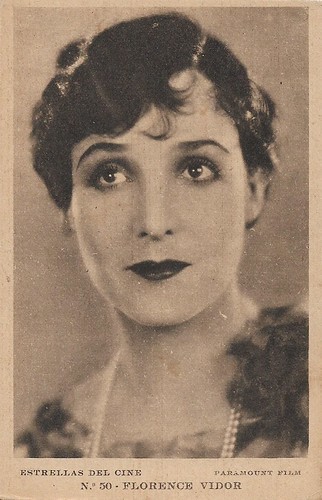
Spanish postcard in the Estrellas del cine series by Editorial Grafica, Barcelona, no. 50. Photo: Paramount Film.
Florence Vidor (1895-1977) was an American silent film actress, who started her career at Vitagraph and her first husband King Vidor's own company. Later, she worked for Paramount in especially sophisticated comedies by Ernst Lubitsch and others.
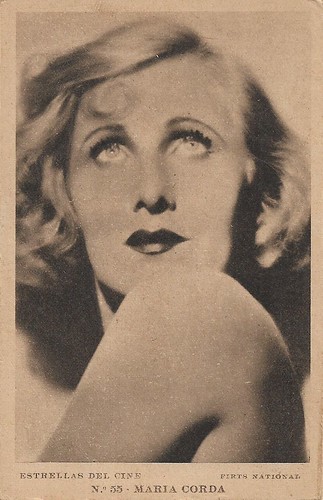
Spanish postcard in the Estrellas del cine series by Editorial Grafica, Barcelona, no. 55. Photo: First National.
Hungarian Maria Corda (1898-1975) was an immensely popular star of the silent cinema of Austria and Germany. The pretty, blonde actress was a queen of the popular epic spectacles of the 1920s, which were often directed by her husband, Alexander Korda. This photo dates from the time Corda acted for First National in The Private Life of Helen of Troy (Alexander Korda, 1927).
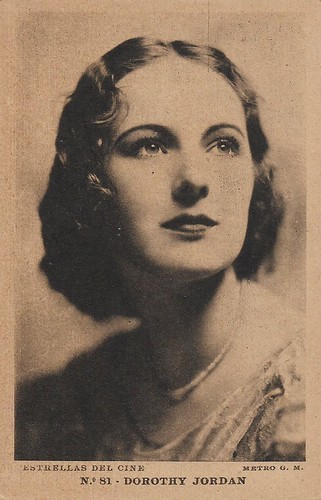
Spanish postcard in the Estrellas del cine series by Editorial Grafica, Barcelona, no. 81. Photo: Metro-Goldwyn-Mayer.
Dorothy Jordan (1906-1988) was an American film actress, who emerged as an actress at the start of the talkies. She made her film debut in 1929 as Mary Pickford's sister in The Taming of the Shrew. Jordan worked for various studios and until 1933 played the female lead in various films. Important parts she had in Min and Bill (1930) with Wallace Beery and Marie Dressler and in The Cabin in the Cotton (1932) with Bette Davis. In 1933 Jordan left the film industry to marry film producer and director Merian C. Cooper.
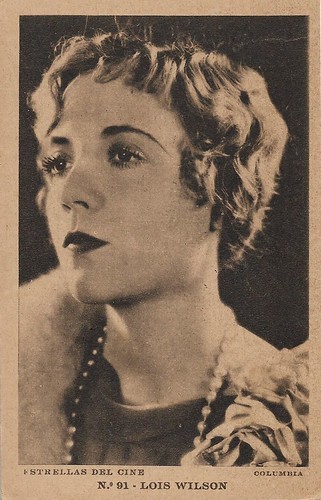
Spanish postcard in the Estrellas del cine series by Editorial Grafica, Barcelona, no. 91. Photo: Columbia Pictures.
American actress Lois Wilson (1894-1988) played the title role in two remarkable, still existing films by William DeMille, Midsummer Madness (1920), with Jack Holt and Conrad Nagel, and the silent comedy-drama Miss Lulu Bett (1921), about a once-timid young woman who gains newfound confidence after a failed marriage, much to the chagrin of her miserable family. After that, Wilson appeared opposite J. Warren Kerrigan in the epic Western The Covered Wagon (James Cruze, 1923) and as Daisy Buchanan in The Great Gatsby (Herbert Brenon, 1926).
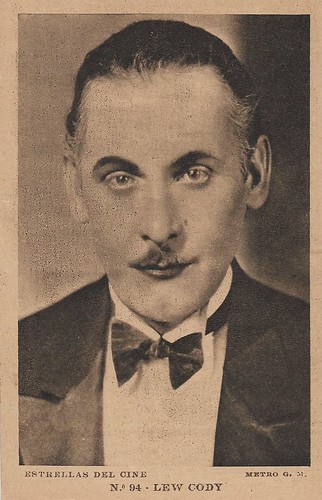
Spanish postcard in the Estrellas del cine series by Editorial Grafica, Barcelona, no. 94. Photo: Metro-Goldwyn-Mayer.
Lew Cody (1884-1934) was an American actor of the silent screen. With his mustache and air of a seducer, he became very popular in roles that used his vivacious charm, either as protagonist or antagonist. He played the playboy Schuyler van Sutphen in Cecil B. DeMille's society comedy Don't Change Your Husband, starring Gloria Swanson. From the mid-1920s until 1930 Cody was a steady actor at MGM, where he often was paired with the French Renée Adorée.
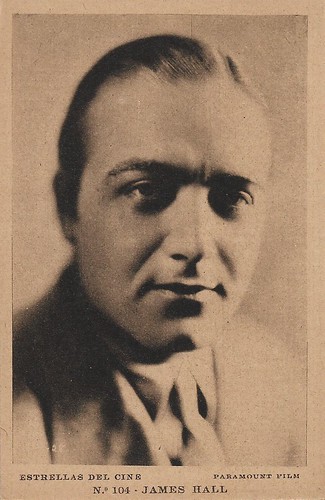
Spanish postcard in the Estrellas del cine series by Editorial Grafica, Barcelona, no. 104. Photo: Paramount Film.
James Hall (1900-1940) was an American actor of the silent and early talkies era. In 1928 he could be seen in Four Sons (John Ford, 1928) as a German immigrant in the USA who is fighting against his homeland in the war. Hall made his sound film debut in The Canary Murder Case (1929), opposite William Powell and Louise Brooks. With the dawn of the talkies at the end of the 1920s, his career was in descent, but in 1930 he played his best-known role in Howard Hughes’ flying epic Hell's Angels.
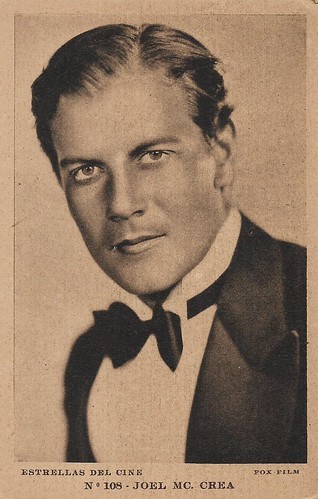
Spanish postcard in the Estrellas del cine series by Editorial Grafica, Barcelona, no. 108. Photo: Fox Film.
American actor Joel McCrea (1905-1990) appeared in hundred films in almost five decades. His best-known films include Alfred Hitchcock's espionage thriller Foreign Correspondent (1940), Preston Sturges' comedy classics Sullivan's Travels (1941), and The Palm Beach Story (1942), the romance film Bird of Paradise (1932), and the adventure classic The Most Dangerous Game (1932). Latert, he starred in many Westerns, including Wichita (1955) as Wyatt Earp and Sam Peckinpah's Ride the High Country (1962), opposite Randolph Scott.
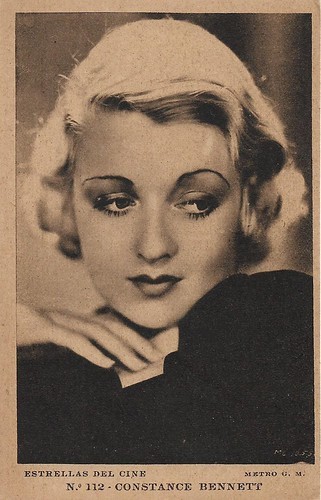
Spanish postcard in the Estrellas del cine series by Editorial Grafica, Barcelona, no. 112. Photo: Metro-Goldwyn-Mayer.
Constance Bennett (1904-1965) was a Hollywood star of the 1920s and 1930s. In the early 1930s, she was for a time Hollywood's most popular and best-paid star and is known for What Price Hollywood? (George Cukor, 1932). She was the older sister of actress Joan Bennett.
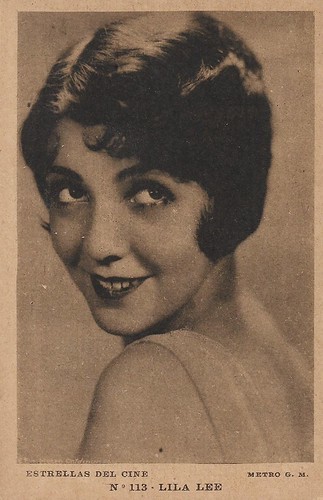
Spanish postcard in the Estrellas del cine series by Editorial Grafica, Barcelona, no. 113. Photo: Metro-Goldwyn-Mayer.
Lila Lee (1901–1973) was a prominent American screen actress, primarily a leading lady, of the silent film and early sound film eras.
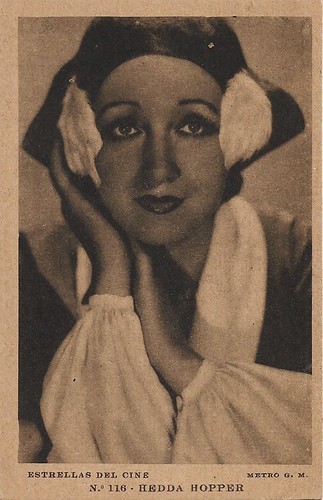
Spanish postcard in the Estrellas del cine series by Editorial Grafica, Barcelona, no. 116. Photo: Metro-Goldwyn-Mayer.
Hedda Hopper (1890-1966) was an American actress but is better known as one of Hollywood's best-known and most-feared reporters.
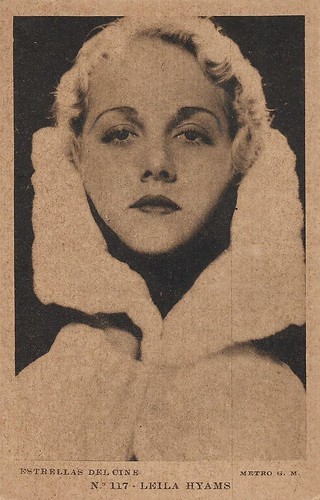
Spanish postcard in the Estrellas del cine series by Editorial Grafica, Barcelona, no. 117. Photo: Metro-Goldwyn-Mayer.
Charming American model, vaudeville, and film actress Leila Hyams (1905-1977) was one of Hollywood's top leading ladies of the early talkie pre-code years. She had spark, personality, and charisma, and a touch of down-to-earthiness and naturalness that won over movie fans; they could relate to her. She is best known for her roles in the classic horror features Freaks (1932) and Island of Lost Souls (1932). Her career lasted little more than a decade.
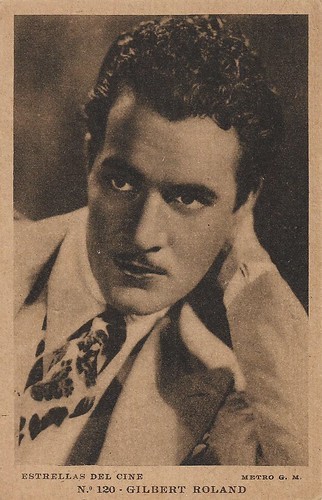
Spanish postcard in the Estrellas del cine series by Editorial Grafica, Barcelona, no. 120. Photo: Metro-Goldwyn-Mayer.
Mexican-born American film star Gilbert Roland (1905–1994) was often cast as the 'Latin Lover' during the silent era. Roland later played romantic lead roles in Spanish language adaptations of American films. In the mid-1940s, he featured in the popular film series around The Cisco Kid. Beginning in the 1940s, critics began to take notice of his acting and he was praised for his supporting roles in John Huston's We Were Strangers (1949), The Bad and the Beautiful (1952), and Cheyenne Autumn (1964). His last film appearance was in the Western Barbarosa (1984).
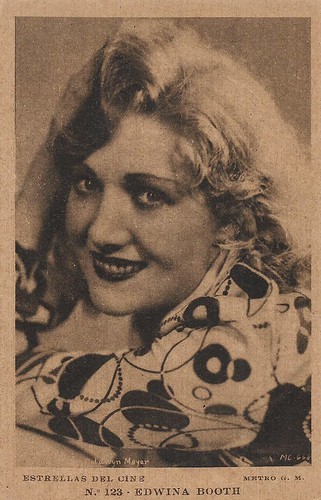
Spanish postcard in the Estrellas del cine series by Editorial Grafica, Barcelona, no. 123. Photo: Metro-Goldwyn-Mayer.
Edwina Booth (1904-1991) was an American actress, who is best known for the adventure film Trader Horn (W.S. Van Dyke, 1929-1931). During the filming on location in Africa, she contracted an illness that effectively ended her film career.
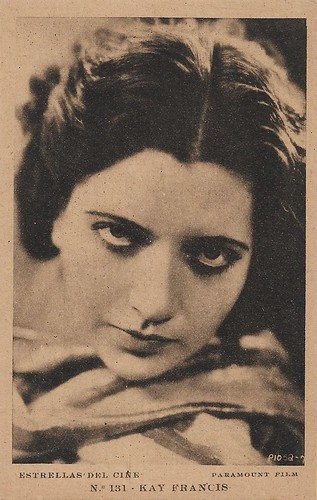
Spanish postcard in the Estrellas del cine series by Editorial Grafica, Barcelona, no. 131. Photo: Paramount Films.
Kay Francis (1905-1968) was an American stage and film actress, known for films such as Ernst Lubitsch's Trouble in Paradise (1932). After a brief period on Broadway in the late 1920s, she moved to Hollywood and achieved her greatest success between 1930 and 1936. She began at Paramount as an early sound film star but then she moved to the Warner Brothers studio, where she became the highest-paid American film actress in those years. In 1939 she was declared box-office poison. She was first reduced to supporting parts and eventually had to work on Poverty Row.
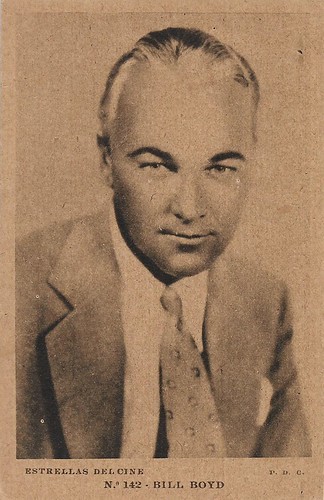
Spanish postcard in the Estrellas del cine series by Editorial Grafica, Barcelona, no. 142. Photo: P.D.C. (Producers Distributing Corporation), a company that existed between 1924 and 1927.
William Boyd (1895-1972) was an American film actor, best known for his parts in Westerns.
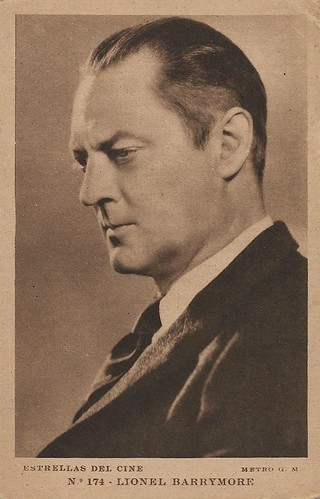
Spanish postcard in the Estrellas del cine series by Editorial Grafica, Barcelona, no. 174. Photo: Metro-Goldwyn-Mayer.
American actor Lionel Barrymore(1878-1954) was first seen on the silver screen in 1908. Between 1911 and 1917, Lionel made 93 films. Later, at MGM, he worked non-stop in the most famous films during the 1930s, 1940s, and 1950s. Lionel received an Oscar for A Free Soul (1930).
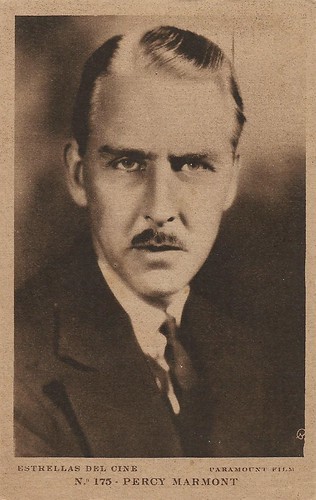
Spanish postcard in the Estrellas del cine series by Editorial Grafica, Barcelona, no. 175. Photo: Paramount Film.
Percy Marmont (1883-1977) was a British actor, who had a prolific career in 1920s Hollywood and 1930s British cinema.
For the full Estrellas del cine series, see Prospectos de cine.

Spanish postcard in the Estrellas del cine series by Editorial Grafica, Barcelona, no. 50. Photo: Paramount Film.
Florence Vidor (1895-1977) was an American silent film actress, who started her career at Vitagraph and her first husband King Vidor's own company. Later, she worked for Paramount in especially sophisticated comedies by Ernst Lubitsch and others.

Spanish postcard in the Estrellas del cine series by Editorial Grafica, Barcelona, no. 55. Photo: First National.
Hungarian Maria Corda (1898-1975) was an immensely popular star of the silent cinema of Austria and Germany. The pretty, blonde actress was a queen of the popular epic spectacles of the 1920s, which were often directed by her husband, Alexander Korda. This photo dates from the time Corda acted for First National in The Private Life of Helen of Troy (Alexander Korda, 1927).

Spanish postcard in the Estrellas del cine series by Editorial Grafica, Barcelona, no. 81. Photo: Metro-Goldwyn-Mayer.
Dorothy Jordan (1906-1988) was an American film actress, who emerged as an actress at the start of the talkies. She made her film debut in 1929 as Mary Pickford's sister in The Taming of the Shrew. Jordan worked for various studios and until 1933 played the female lead in various films. Important parts she had in Min and Bill (1930) with Wallace Beery and Marie Dressler and in The Cabin in the Cotton (1932) with Bette Davis. In 1933 Jordan left the film industry to marry film producer and director Merian C. Cooper.

Spanish postcard in the Estrellas del cine series by Editorial Grafica, Barcelona, no. 91. Photo: Columbia Pictures.
American actress Lois Wilson (1894-1988) played the title role in two remarkable, still existing films by William DeMille, Midsummer Madness (1920), with Jack Holt and Conrad Nagel, and the silent comedy-drama Miss Lulu Bett (1921), about a once-timid young woman who gains newfound confidence after a failed marriage, much to the chagrin of her miserable family. After that, Wilson appeared opposite J. Warren Kerrigan in the epic Western The Covered Wagon (James Cruze, 1923) and as Daisy Buchanan in The Great Gatsby (Herbert Brenon, 1926).

Spanish postcard in the Estrellas del cine series by Editorial Grafica, Barcelona, no. 94. Photo: Metro-Goldwyn-Mayer.
Lew Cody (1884-1934) was an American actor of the silent screen. With his mustache and air of a seducer, he became very popular in roles that used his vivacious charm, either as protagonist or antagonist. He played the playboy Schuyler van Sutphen in Cecil B. DeMille's society comedy Don't Change Your Husband, starring Gloria Swanson. From the mid-1920s until 1930 Cody was a steady actor at MGM, where he often was paired with the French Renée Adorée.

Spanish postcard in the Estrellas del cine series by Editorial Grafica, Barcelona, no. 104. Photo: Paramount Film.
James Hall (1900-1940) was an American actor of the silent and early talkies era. In 1928 he could be seen in Four Sons (John Ford, 1928) as a German immigrant in the USA who is fighting against his homeland in the war. Hall made his sound film debut in The Canary Murder Case (1929), opposite William Powell and Louise Brooks. With the dawn of the talkies at the end of the 1920s, his career was in descent, but in 1930 he played his best-known role in Howard Hughes’ flying epic Hell's Angels.

Spanish postcard in the Estrellas del cine series by Editorial Grafica, Barcelona, no. 108. Photo: Fox Film.
American actor Joel McCrea (1905-1990) appeared in hundred films in almost five decades. His best-known films include Alfred Hitchcock's espionage thriller Foreign Correspondent (1940), Preston Sturges' comedy classics Sullivan's Travels (1941), and The Palm Beach Story (1942), the romance film Bird of Paradise (1932), and the adventure classic The Most Dangerous Game (1932). Latert, he starred in many Westerns, including Wichita (1955) as Wyatt Earp and Sam Peckinpah's Ride the High Country (1962), opposite Randolph Scott.

Spanish postcard in the Estrellas del cine series by Editorial Grafica, Barcelona, no. 112. Photo: Metro-Goldwyn-Mayer.
Constance Bennett (1904-1965) was a Hollywood star of the 1920s and 1930s. In the early 1930s, she was for a time Hollywood's most popular and best-paid star and is known for What Price Hollywood? (George Cukor, 1932). She was the older sister of actress Joan Bennett.

Spanish postcard in the Estrellas del cine series by Editorial Grafica, Barcelona, no. 113. Photo: Metro-Goldwyn-Mayer.
Lila Lee (1901–1973) was a prominent American screen actress, primarily a leading lady, of the silent film and early sound film eras.

Spanish postcard in the Estrellas del cine series by Editorial Grafica, Barcelona, no. 116. Photo: Metro-Goldwyn-Mayer.
Hedda Hopper (1890-1966) was an American actress but is better known as one of Hollywood's best-known and most-feared reporters.

Spanish postcard in the Estrellas del cine series by Editorial Grafica, Barcelona, no. 117. Photo: Metro-Goldwyn-Mayer.
Charming American model, vaudeville, and film actress Leila Hyams (1905-1977) was one of Hollywood's top leading ladies of the early talkie pre-code years. She had spark, personality, and charisma, and a touch of down-to-earthiness and naturalness that won over movie fans; they could relate to her. She is best known for her roles in the classic horror features Freaks (1932) and Island of Lost Souls (1932). Her career lasted little more than a decade.

Spanish postcard in the Estrellas del cine series by Editorial Grafica, Barcelona, no. 120. Photo: Metro-Goldwyn-Mayer.
Mexican-born American film star Gilbert Roland (1905–1994) was often cast as the 'Latin Lover' during the silent era. Roland later played romantic lead roles in Spanish language adaptations of American films. In the mid-1940s, he featured in the popular film series around The Cisco Kid. Beginning in the 1940s, critics began to take notice of his acting and he was praised for his supporting roles in John Huston's We Were Strangers (1949), The Bad and the Beautiful (1952), and Cheyenne Autumn (1964). His last film appearance was in the Western Barbarosa (1984).

Spanish postcard in the Estrellas del cine series by Editorial Grafica, Barcelona, no. 123. Photo: Metro-Goldwyn-Mayer.
Edwina Booth (1904-1991) was an American actress, who is best known for the adventure film Trader Horn (W.S. Van Dyke, 1929-1931). During the filming on location in Africa, she contracted an illness that effectively ended her film career.

Spanish postcard in the Estrellas del cine series by Editorial Grafica, Barcelona, no. 131. Photo: Paramount Films.
Kay Francis (1905-1968) was an American stage and film actress, known for films such as Ernst Lubitsch's Trouble in Paradise (1932). After a brief period on Broadway in the late 1920s, she moved to Hollywood and achieved her greatest success between 1930 and 1936. She began at Paramount as an early sound film star but then she moved to the Warner Brothers studio, where she became the highest-paid American film actress in those years. In 1939 she was declared box-office poison. She was first reduced to supporting parts and eventually had to work on Poverty Row.

Spanish postcard in the Estrellas del cine series by Editorial Grafica, Barcelona, no. 142. Photo: P.D.C. (Producers Distributing Corporation), a company that existed between 1924 and 1927.
William Boyd (1895-1972) was an American film actor, best known for his parts in Westerns.

Spanish postcard in the Estrellas del cine series by Editorial Grafica, Barcelona, no. 174. Photo: Metro-Goldwyn-Mayer.
American actor Lionel Barrymore(1878-1954) was first seen on the silver screen in 1908. Between 1911 and 1917, Lionel made 93 films. Later, at MGM, he worked non-stop in the most famous films during the 1930s, 1940s, and 1950s. Lionel received an Oscar for A Free Soul (1930).

Spanish postcard in the Estrellas del cine series by Editorial Grafica, Barcelona, no. 175. Photo: Paramount Film.
Percy Marmont (1883-1977) was a British actor, who had a prolific career in 1920s Hollywood and 1930s British cinema.
For the full Estrellas del cine series, see Prospectos de cine.
Published on April 28, 2021 22:00
April 27, 2021
Yvette Mimieux
American actress and writer Yvette Mimieux (1942) is known for The Time Machine (1960), and several other popular films of the 1960s. She was nominated for three Golden Globe awards during her acting career.
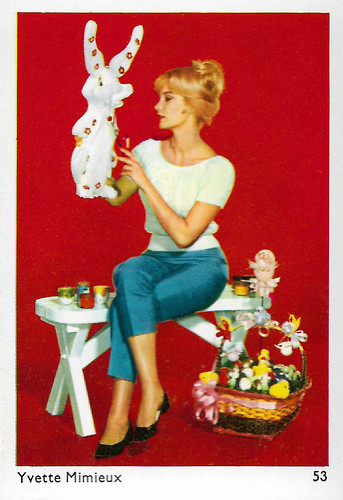
West-German collectors card, no. 53.
800,000 years into the future
Yvette Carmen Mimieux was born in Los Angeles, California, in 1942. Her French father was René Mimieux and her Mexican mother Maria Montemayor. She has at least two siblings: sister Gloria and a brother.
The blonde, well-proportioned Mimieux was a beauty contest winner and model when talent manager Jim Byron suggested she become an actress. Her first acting appearances were in episodes of the television shows Yancy Derringer and One Step Beyond.
In 1960, she made her film debut, the Science Fiction film The Time Machine (George Pal, 1960). In George Pal's production of the H.G. Wells novel about time travel, Wells (Rod Taylor) travels 800,000 years into the future and falls for Weena (Mimieux) of the peaceful Eloi who are threatened by the Morlocks, cannibalistic mutations. It was made for MGM, which put her under a long-term contract.
Her breakthrough role was followed by roles in Platinum High School (Charles Haas, 1960), with Mickey Rooney and Terry Moore, and the first beach-party movie, Where the Boys Are (Henry Levin, 1960) with George Hamilton.
Where the Boys Are was one of the first teen films to explore adolescent sexuality and the changing sexual morals and attitudes among American college youth. Aimed at the teen market, it inspired many American college students to head to Fort Lauderdale for their annual spring break.
MGM put Mimieux in the ingenue role in Four Horsemen of the Apocalypse (Vincente Minelli, 1961), an expensive flop. She had a central role in Light in the Piazza (Guy Green, 1962) with Olivia de Havilland, Rossano Brazzi , and George Hamilton, playing a mentally disabled girl. The film lost money but was well regarded critically.
She had a small part in The Wonderful World of the Brothers Grimm (George Pal, 1963), another commercial disappointment. Also later that year, she appeared in Diamond Head (Guy Green, 1963) for Columbia, billed second to Charlton Heston .
She went to United Artists for Toys in the Attic, based on the play by Lillian Hellman and co-starring Dean Martin. On TV, Mimieux guest-starred on two episodes of Dr. Kildare alongside Richard Chamberlain. Hal Erickson at AllMovie : "An appearance as a terminally ill girl on the 1964 Dr. Kildare episode "Tyger Tyger" drew a great deal of press attention for Mimieux, principally because she spent most of her early scenes in a bikini. The actress's subsequent roles showed promise, but she generally found herself playing second fiddle to the leading man."
Mimieux made a cameo as herself in the comedy-musical Looking for Love (Don Weis, 1964) starring popular singer Connie Francis and played Richard Chamberlain's love interest in the romance Joy in the Morning (Alex Segal, 1965).
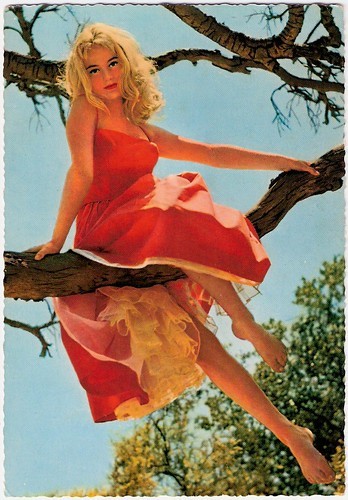
German postcard by Krüger, no. 902/370. Photo: Gérard Decaux.
Unhappy with the "one-dimensional" roles offered to female actors
Post-MGM, Yvette Mimieux was in the Western The Reward (Serge Bourguignon, 1965) with Max von Sydow, the Disney comedy Monkeys, Go Home! (Andrew V. McLaglen, 1967) with Maurice Chevalier , and the heist film The Caper of the Golden Bulls (Russell Rouse, 1967) starring Stephen Boyd .
She was reunited with Rod Taylor in the action film Dark of the Sun (Jack Cardiff, 1968). Mimieux was top-billed in the hit Three in the Attic (Richard Wilson, 1969) with Christopher Lee , and appeared in the critically acclaimed film The Picasso Summer (Serge Bourguignon, Robert Sallin, 1969) alongside Albert Finney .
Mimieux was the female lead in the action film The Delta Factor (Tay Garnett, 1970), based on the 1967 novel by Mickey Spillane. She then had one of the leads in The Most Deadly Game (1970–1971), a short-lived TV series from Aaron Spelling.
Around this time Mimieux had a business selling Haitian products and she studied archeology and would travel several months of each year. In 1971 she sued her agent for not providing her with movie work despite taking money.
She was an air hostess in the disaster film Skyjacked (John Guillermin, 1972), starring Charlton Heston , and appeared in the Science-Fiction film The Neptune Factor (Daniel Petrie, 1973). By the early 1970s, Mimieux was unhappy with the "one-dimensional" roles offered to female actors: "There's nothing to play. They're either sex objects or vanilla pudding.
Mimieux had been writing for several years, mostly journalism and short stories. She wrote a thriller, which she took to producers Aaron Spelling and Leonard Goldberg, who then produced it for ABC as a television film. It aired as Hit Lady (Tracy Keenan Wynn, 1974). Hal Erickson at AllMovie : "she is undeniably impressive as a scantily clad professional assassin".
Mimieux starred in The Legend of Valentino (Melville Shavelson, 1975), in which she played Rudolph Valentino's ( Franco Nero ) second wife, Natacha Rambova. Also in 1975, she made the Canadian thriller Journey into Fear (Daniel Petrie, 1975), a remake of the spy film Journey into Fear (Norman Foster, 1943) starring Orson Welles .
Mimieux was a falsely imprisoned woman victimised by a sadistic guard in the exploitation film Jackson County Jail (Michael Miller, 1976) with Tommy Lee Jones. The 'drive-in' film has become a cult film and was selected by film director Quentin Tarantino for the first Quentin Tarantino Film Festival in Austin, Texas, in 1996.
Mimieux co-starred in the first PG-rated Walt Disney Productions feature, The Black Hole (Gary Nelson, 1979) starring Maximilian Schell and Anthony Perkins . She had the lead as the chief executive of a giant corporation called "Mystique" in Circle of Power (Bobby Roth, 1981).
She appeared in several TV movies and guest-starred on The Love Boat (1984), Lime Street (1985), and Perry Mason: The Case of the Desperate Deception (1990). Her last appearance was in the TV mini-series Lady Boss (Charles Jarrott, 1992), based on a novel written by Jackie Collins. After this role, she retired from acting.
Yvette Mimieux married three times. In 1959, she married Evan Harland Engber but kept the marriage secret for almost two years. She was married to film director Stanley Donen from 1972 until their divorce in 1985. In 1986, Mimieux married Howard F. Ruby, chairman emeritus and founder of Oakwood Worldwide.
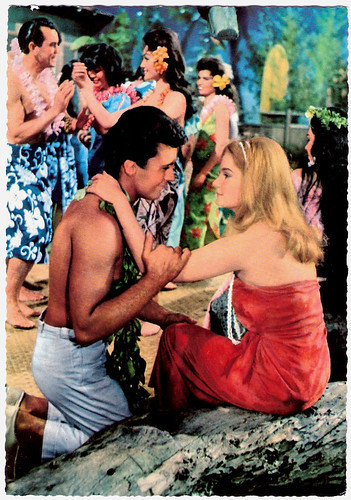
German postcard by Krüger, no. 902/254. Photo: Yvette Mimieux and James Darren in Diamond Head (Guy Green, 1963).
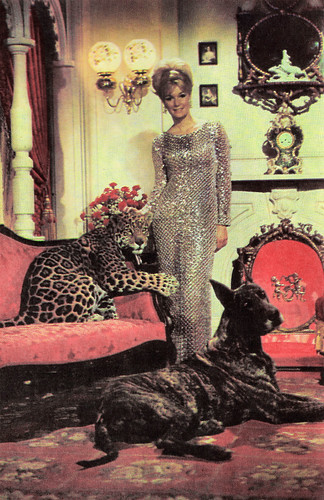
Romanian postcard by Casa Filmului Acin, no. 90.
Sources: Hal Erickson (AllMovie), Wikipedia, and .

West-German collectors card, no. 53.
800,000 years into the future
Yvette Carmen Mimieux was born in Los Angeles, California, in 1942. Her French father was René Mimieux and her Mexican mother Maria Montemayor. She has at least two siblings: sister Gloria and a brother.
The blonde, well-proportioned Mimieux was a beauty contest winner and model when talent manager Jim Byron suggested she become an actress. Her first acting appearances were in episodes of the television shows Yancy Derringer and One Step Beyond.
In 1960, she made her film debut, the Science Fiction film The Time Machine (George Pal, 1960). In George Pal's production of the H.G. Wells novel about time travel, Wells (Rod Taylor) travels 800,000 years into the future and falls for Weena (Mimieux) of the peaceful Eloi who are threatened by the Morlocks, cannibalistic mutations. It was made for MGM, which put her under a long-term contract.
Her breakthrough role was followed by roles in Platinum High School (Charles Haas, 1960), with Mickey Rooney and Terry Moore, and the first beach-party movie, Where the Boys Are (Henry Levin, 1960) with George Hamilton.
Where the Boys Are was one of the first teen films to explore adolescent sexuality and the changing sexual morals and attitudes among American college youth. Aimed at the teen market, it inspired many American college students to head to Fort Lauderdale for their annual spring break.
MGM put Mimieux in the ingenue role in Four Horsemen of the Apocalypse (Vincente Minelli, 1961), an expensive flop. She had a central role in Light in the Piazza (Guy Green, 1962) with Olivia de Havilland, Rossano Brazzi , and George Hamilton, playing a mentally disabled girl. The film lost money but was well regarded critically.
She had a small part in The Wonderful World of the Brothers Grimm (George Pal, 1963), another commercial disappointment. Also later that year, she appeared in Diamond Head (Guy Green, 1963) for Columbia, billed second to Charlton Heston .
She went to United Artists for Toys in the Attic, based on the play by Lillian Hellman and co-starring Dean Martin. On TV, Mimieux guest-starred on two episodes of Dr. Kildare alongside Richard Chamberlain. Hal Erickson at AllMovie : "An appearance as a terminally ill girl on the 1964 Dr. Kildare episode "Tyger Tyger" drew a great deal of press attention for Mimieux, principally because she spent most of her early scenes in a bikini. The actress's subsequent roles showed promise, but she generally found herself playing second fiddle to the leading man."
Mimieux made a cameo as herself in the comedy-musical Looking for Love (Don Weis, 1964) starring popular singer Connie Francis and played Richard Chamberlain's love interest in the romance Joy in the Morning (Alex Segal, 1965).

German postcard by Krüger, no. 902/370. Photo: Gérard Decaux.
Unhappy with the "one-dimensional" roles offered to female actors
Post-MGM, Yvette Mimieux was in the Western The Reward (Serge Bourguignon, 1965) with Max von Sydow, the Disney comedy Monkeys, Go Home! (Andrew V. McLaglen, 1967) with Maurice Chevalier , and the heist film The Caper of the Golden Bulls (Russell Rouse, 1967) starring Stephen Boyd .
She was reunited with Rod Taylor in the action film Dark of the Sun (Jack Cardiff, 1968). Mimieux was top-billed in the hit Three in the Attic (Richard Wilson, 1969) with Christopher Lee , and appeared in the critically acclaimed film The Picasso Summer (Serge Bourguignon, Robert Sallin, 1969) alongside Albert Finney .
Mimieux was the female lead in the action film The Delta Factor (Tay Garnett, 1970), based on the 1967 novel by Mickey Spillane. She then had one of the leads in The Most Deadly Game (1970–1971), a short-lived TV series from Aaron Spelling.
Around this time Mimieux had a business selling Haitian products and she studied archeology and would travel several months of each year. In 1971 she sued her agent for not providing her with movie work despite taking money.
She was an air hostess in the disaster film Skyjacked (John Guillermin, 1972), starring Charlton Heston , and appeared in the Science-Fiction film The Neptune Factor (Daniel Petrie, 1973). By the early 1970s, Mimieux was unhappy with the "one-dimensional" roles offered to female actors: "There's nothing to play. They're either sex objects or vanilla pudding.
Mimieux had been writing for several years, mostly journalism and short stories. She wrote a thriller, which she took to producers Aaron Spelling and Leonard Goldberg, who then produced it for ABC as a television film. It aired as Hit Lady (Tracy Keenan Wynn, 1974). Hal Erickson at AllMovie : "she is undeniably impressive as a scantily clad professional assassin".
Mimieux starred in The Legend of Valentino (Melville Shavelson, 1975), in which she played Rudolph Valentino's ( Franco Nero ) second wife, Natacha Rambova. Also in 1975, she made the Canadian thriller Journey into Fear (Daniel Petrie, 1975), a remake of the spy film Journey into Fear (Norman Foster, 1943) starring Orson Welles .
Mimieux was a falsely imprisoned woman victimised by a sadistic guard in the exploitation film Jackson County Jail (Michael Miller, 1976) with Tommy Lee Jones. The 'drive-in' film has become a cult film and was selected by film director Quentin Tarantino for the first Quentin Tarantino Film Festival in Austin, Texas, in 1996.
Mimieux co-starred in the first PG-rated Walt Disney Productions feature, The Black Hole (Gary Nelson, 1979) starring Maximilian Schell and Anthony Perkins . She had the lead as the chief executive of a giant corporation called "Mystique" in Circle of Power (Bobby Roth, 1981).
She appeared in several TV movies and guest-starred on The Love Boat (1984), Lime Street (1985), and Perry Mason: The Case of the Desperate Deception (1990). Her last appearance was in the TV mini-series Lady Boss (Charles Jarrott, 1992), based on a novel written by Jackie Collins. After this role, she retired from acting.
Yvette Mimieux married three times. In 1959, she married Evan Harland Engber but kept the marriage secret for almost two years. She was married to film director Stanley Donen from 1972 until their divorce in 1985. In 1986, Mimieux married Howard F. Ruby, chairman emeritus and founder of Oakwood Worldwide.

German postcard by Krüger, no. 902/254. Photo: Yvette Mimieux and James Darren in Diamond Head (Guy Green, 1963).

Romanian postcard by Casa Filmului Acin, no. 90.
Sources: Hal Erickson (AllMovie), Wikipedia, and .
Published on April 27, 2021 22:00
April 26, 2021
Val d'Olivi (1916)
The Italian film studio Ambrosio produced Val d'Olivi/Velley of the Olive Trees (Eleuterio Rodolfi, 1916) to boost the war effort during the First World War. The historical film looked back at the struggles during the liberation and unification of Italy in the 19th century, known as the 'Risorgimento'. The lead actors were Tullio Carminati, Paul Donadio, and Polish singer and actress Helena Makowska, and the film was based on the romantic novel by Anton Giulio Barrili (1873). Ivo Blom acquired the complete original Italian set of 12 postcards made by IPA CP Duplex to promote the film.
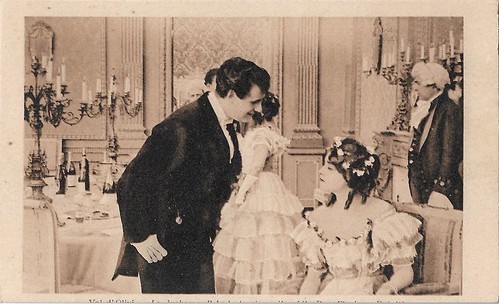
Italian postcard by V. Uff. Rev. St., Terni / IPA CT Duplex. no. 1702. Photo: Film Società Anonima Ambrosio Torino. Postcard for the Italian historical propaganda film Val d'Olivi (Eleuterio Rodolfi, 1916). Caption: The duchess d'Andrate ( Helena Makowska ) and Don Flavio Delaiti ( Tullio Carminati ).
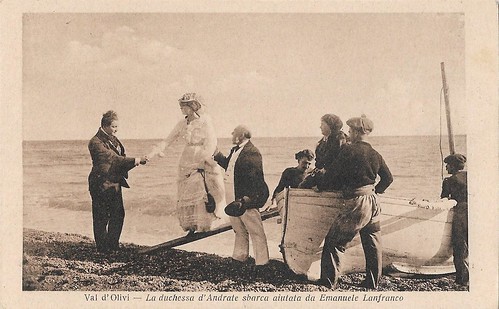
Italian postcard by V. Uff. Rev. St., Terni / IPA CT Duplex. no. 1703. Photo: Film Società Anonima Ambrosio Torino. Postcard for Val d'Olivi (Eleuterio Rodolfi, 1916). Caption: The duchess of Andrate ( Helena Makowska ) disembarks, helped by Emanuele Lanfranco (Paul Donadio). The old man helping her too is Lanfranco's father (Umberto Scalpellini).
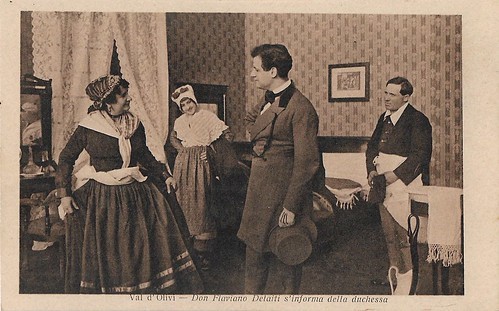
Italian postcard by V. Uff. Rev. St., Terni / IPA CT Duplex. no. 1704. Photo: Film Società Anonima Ambrosio Torino. Postcard for Val d'Olivi (Eleuterio Rodolfi, 1916). Caption: Don Flaviano Delaiti ( Tullio Carminati ) informs himself about the duchess.
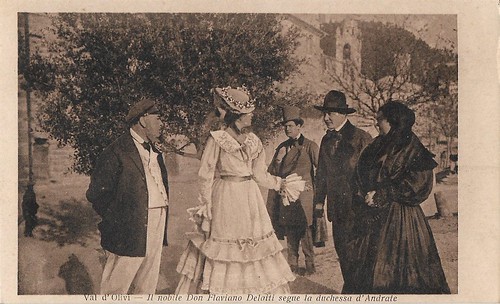
Italian postcard by V. Uff. Rev. St., Terni / IPA CT Duplex. no. 1705. Photo: Film Società Anonima Ambrosio Torino. Postcard for Val d'Olivi (Eleuterio Rodolfi, 1916). Caption: The aristocrat Don Flaviano Delaiti ( Tullio Carminati ) follows the duchess of Andrate ( Helena Makowska ). Carminati stands in the back. Left of Makowska we see Umberto Scalpellini as the old naval captain Lanfranco and right of her Paul Donadio as Emanuele Lanfranco.
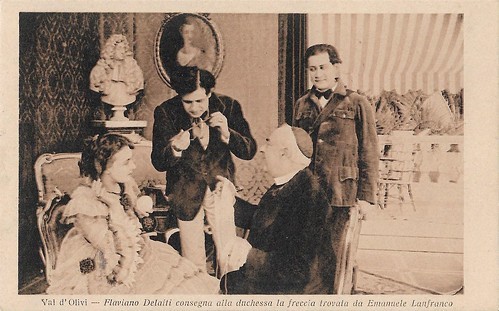
Italian postcard by V. Uff. Rev. St., Terni / IPA CT Duplex. no. 1706. Photo: Film Società Anonima Ambrosio Torino. Postcard for Val d'Olivi (Eleuterio Rodolfi, 1916). Caption: Flaviano Delaiti ( Tullio Carmminati ) delivers the duchess ( Helena Makowska ) the arrow found by Emanuele Lanfranco (Paul Donadio).
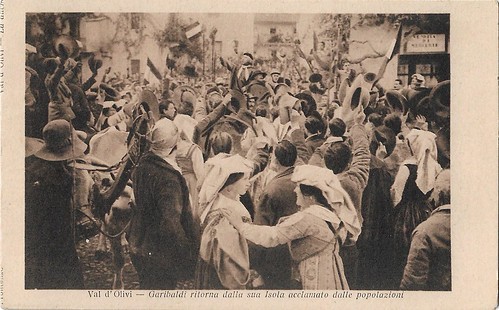
Italian postcard by V. Uff. Rev. St., Terni / IPA CT Duplex. no. 1707. Photo: Film Società Anonima Ambrosio Torino. Postcard for Val d'Olivi (Eleuterio Rodolfi, 1916). Caption: Garibaldi returns from his island, acclaimed by the populace.
A difficult adaptation of a romantic, sentimental novel
The author of 'Val d'Olivi', the Italian novelist and journalist Anton Giulio Barrili (1836-1908), was a volunteer in the campaign of 1859 and served with Garibaldi in 1866 and 1867. From 1865 onwards he published a large number of books of fiction, which had wide popularity.
Some of the best of his later novels are 'Santa Cecilia' (1866), 'Come un Sogno' (1875), and 'L’Olmo e l'Edera' (1877). Barrili also wrote two plays and various volumes of criticism, including 'Il rinnovamento letterario italiano' (1890). He was elected to the Italian chamber of deputies in 1876; and in 1889 became professor of Italian literature at Genoa.
Barrili's 'Val d'Olivi' appeared in 1873. Arrigo Frusta turned the novel into a film script for Ambrosio. Dawn of 28 February 1867, the gentleman Flaviano Delaiti returns from a trip to France to Liguria, but his coach is overthrown. On foot, he arrives at Noli, where he sees a boat landing. Among the people descending is Donna Giulia, whom he courted in vain in Milan in his younger years. She married but her husband, an unworthy man, died.
Hoping to rekindle the old flame and the gaiety of their old times in Milan, Flaviano starts courting Giulia again, but she prefers another man, the timid Emanuele, nephew of Captain Lanfranco. Emotions are cooked up, and finally, the two men declare each other their love for the same woman. A duel is pending. But Giulia rejects Flaviano and when Emanuele manages to declare her his love, she remains silent.
So both men leave for war when Garibaldi from Caprera raises his call for volunteers to free Italy. The two rivals in love meet again in Garibaldi's army., which crosses the border of the Papal State and heads for Rome. At last, Giulia recognises her love for Emanuele, and with his uncle she searches for him at the battlefield. Severely wounded, Emanuele forgets his pains in the arms of his beloved.
While Garibaldi's army is standing before Rome, Flaviano is shot and dies. His last thoughts are for his beloved Giulia. "Thus Flaviano Delaiti died, eight months after his trip to France and his return to Liguria." Val d'Olivi, directed by Eleuterio Rodolfi, premiered in Rome on 3 May 1916, during the First World War.
The press was mixed about the film. Fandor, in the Roman journal Il Tirso al Cinematografo (7.5.1916) lauded what must have been a difficult adaptation of the romantic, sentimental novel and praised Rodolfi's balanced and restrained direction. Fandor also praised Carminati's acting, and while judging Makowska's acting cold, it was still promising and foretold a future career.
Instead, Pier da Castello in La Vita Cinematografica (7/ 15.5.1916), by the way a journal based in Ambrosio's hometown Turin, judged the adaptation too schematic and missing the finesses of the novel. While mise-en-scene and cinematography were praised, among the actors Carminati stood out, while Makowska, even if physically beautiful, was felt lifeless.
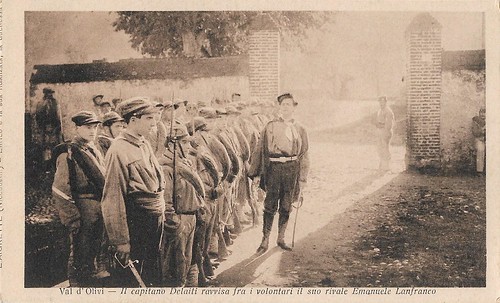
Italian postcard by V. Uff. Rev. St., Terni / IPA CT Duplex. no. 1708. Photo: Film Società Anonima Ambrosio Torino. Postcard for Val d'Olivi (Eleuterio Rodolfi, 1916). Caption: Captain Delaiti ( Tullio Carminati ) recognises his rival Emanuele Lanfranco (Paul Donadio) among the volunteers.
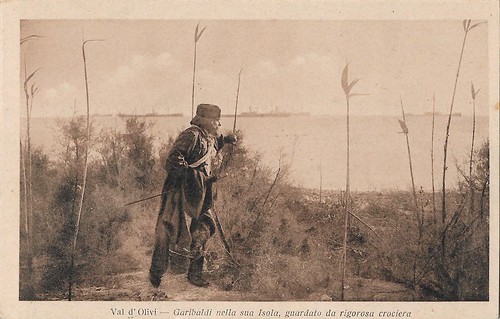
Italian postcard by V. Uff. Rev. St., Terni / IPA CT Duplex. no. 1709. Photo: Film Società Anonima Ambrosio Torino. Postcard for Val d'Olivi (Eleuterio Rodolfi, 1916). Caption: Garibaldi on his island, guarded by rigorous [enemy] battleships.
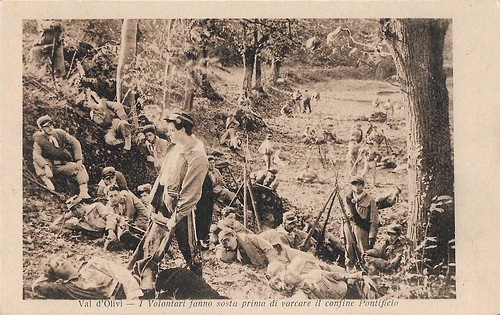
Italian postcard by V. Uff. Rev. St., Terni / IPA CT Duplex. no. 1710. Photo: Film Società Anonima Ambrosio Torino. Postcard for Val d'Olivi (Eleuterio Rodolfi, 1916). Caption: The volunteers have a break before passing the border of the Papal State.
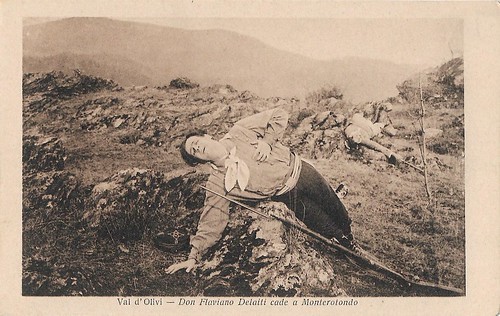
Italian postcard by V. Uff. Rev. St., Terni / IPA CT Duplex. no. 1711. Photo: Film Società Anonima Ambrosio Torino. Postcard for Val d'Olivi (Eleuterio Rodolfi, 1916). Caption: Don Flaviano Delaiti ( Tullio Carminati ) falls at Monterotondo.
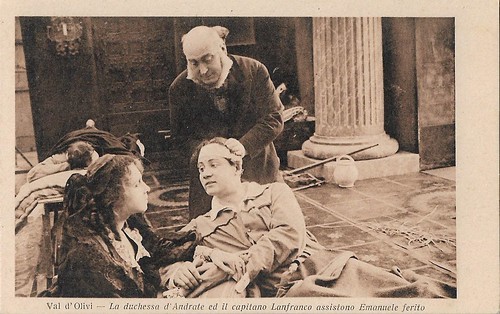
Italian postcard by V. Uff. Rev. St., Terni / IPA CT Duplex. no. 1712. Photo: Film Società Anonima Ambrosio Torino. Postcard for Val d'Olivi (Eleuterio Rodolfi, 1916). Caption: The duchess of Andrate ( Helena Makowska ) and Captain Lanfranco (Umberto Scalpellini) assist the wounded Emmanuele (Paul Donadio).
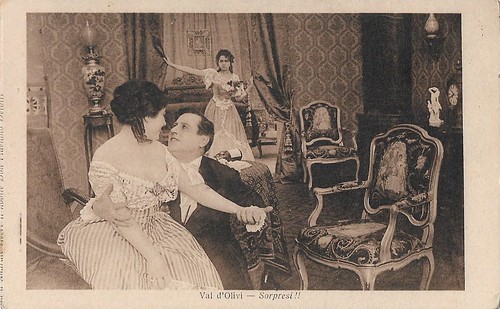
Italian postcard by V. Uff. Rev. St., Terni / IPA CT Duplex. no. 1713. Photo: Film Società Anonima Ambrosio Torino. Postcard for Val d'Olivi (Eleuterio Rodolfi, 1916). Caption: Caught! The actress in the back is Helena Makowska , the man may be Vittorio Rossi-Pianelli.
Sources: Vittorio Martinelli (Il cinema muto italiano, Vol. 1918), Wikipedia (Italian), and IMDb. The plot description is from the Italian-written brochure of the film, kindly shown to us by the Museo Nazionale del Cinema, Turin.

Italian postcard by V. Uff. Rev. St., Terni / IPA CT Duplex. no. 1702. Photo: Film Società Anonima Ambrosio Torino. Postcard for the Italian historical propaganda film Val d'Olivi (Eleuterio Rodolfi, 1916). Caption: The duchess d'Andrate ( Helena Makowska ) and Don Flavio Delaiti ( Tullio Carminati ).

Italian postcard by V. Uff. Rev. St., Terni / IPA CT Duplex. no. 1703. Photo: Film Società Anonima Ambrosio Torino. Postcard for Val d'Olivi (Eleuterio Rodolfi, 1916). Caption: The duchess of Andrate ( Helena Makowska ) disembarks, helped by Emanuele Lanfranco (Paul Donadio). The old man helping her too is Lanfranco's father (Umberto Scalpellini).

Italian postcard by V. Uff. Rev. St., Terni / IPA CT Duplex. no. 1704. Photo: Film Società Anonima Ambrosio Torino. Postcard for Val d'Olivi (Eleuterio Rodolfi, 1916). Caption: Don Flaviano Delaiti ( Tullio Carminati ) informs himself about the duchess.

Italian postcard by V. Uff. Rev. St., Terni / IPA CT Duplex. no. 1705. Photo: Film Società Anonima Ambrosio Torino. Postcard for Val d'Olivi (Eleuterio Rodolfi, 1916). Caption: The aristocrat Don Flaviano Delaiti ( Tullio Carminati ) follows the duchess of Andrate ( Helena Makowska ). Carminati stands in the back. Left of Makowska we see Umberto Scalpellini as the old naval captain Lanfranco and right of her Paul Donadio as Emanuele Lanfranco.

Italian postcard by V. Uff. Rev. St., Terni / IPA CT Duplex. no. 1706. Photo: Film Società Anonima Ambrosio Torino. Postcard for Val d'Olivi (Eleuterio Rodolfi, 1916). Caption: Flaviano Delaiti ( Tullio Carmminati ) delivers the duchess ( Helena Makowska ) the arrow found by Emanuele Lanfranco (Paul Donadio).

Italian postcard by V. Uff. Rev. St., Terni / IPA CT Duplex. no. 1707. Photo: Film Società Anonima Ambrosio Torino. Postcard for Val d'Olivi (Eleuterio Rodolfi, 1916). Caption: Garibaldi returns from his island, acclaimed by the populace.
A difficult adaptation of a romantic, sentimental novel
The author of 'Val d'Olivi', the Italian novelist and journalist Anton Giulio Barrili (1836-1908), was a volunteer in the campaign of 1859 and served with Garibaldi in 1866 and 1867. From 1865 onwards he published a large number of books of fiction, which had wide popularity.
Some of the best of his later novels are 'Santa Cecilia' (1866), 'Come un Sogno' (1875), and 'L’Olmo e l'Edera' (1877). Barrili also wrote two plays and various volumes of criticism, including 'Il rinnovamento letterario italiano' (1890). He was elected to the Italian chamber of deputies in 1876; and in 1889 became professor of Italian literature at Genoa.
Barrili's 'Val d'Olivi' appeared in 1873. Arrigo Frusta turned the novel into a film script for Ambrosio. Dawn of 28 February 1867, the gentleman Flaviano Delaiti returns from a trip to France to Liguria, but his coach is overthrown. On foot, he arrives at Noli, where he sees a boat landing. Among the people descending is Donna Giulia, whom he courted in vain in Milan in his younger years. She married but her husband, an unworthy man, died.
Hoping to rekindle the old flame and the gaiety of their old times in Milan, Flaviano starts courting Giulia again, but she prefers another man, the timid Emanuele, nephew of Captain Lanfranco. Emotions are cooked up, and finally, the two men declare each other their love for the same woman. A duel is pending. But Giulia rejects Flaviano and when Emanuele manages to declare her his love, she remains silent.
So both men leave for war when Garibaldi from Caprera raises his call for volunteers to free Italy. The two rivals in love meet again in Garibaldi's army., which crosses the border of the Papal State and heads for Rome. At last, Giulia recognises her love for Emanuele, and with his uncle she searches for him at the battlefield. Severely wounded, Emanuele forgets his pains in the arms of his beloved.
While Garibaldi's army is standing before Rome, Flaviano is shot and dies. His last thoughts are for his beloved Giulia. "Thus Flaviano Delaiti died, eight months after his trip to France and his return to Liguria." Val d'Olivi, directed by Eleuterio Rodolfi, premiered in Rome on 3 May 1916, during the First World War.
The press was mixed about the film. Fandor, in the Roman journal Il Tirso al Cinematografo (7.5.1916) lauded what must have been a difficult adaptation of the romantic, sentimental novel and praised Rodolfi's balanced and restrained direction. Fandor also praised Carminati's acting, and while judging Makowska's acting cold, it was still promising and foretold a future career.
Instead, Pier da Castello in La Vita Cinematografica (7/ 15.5.1916), by the way a journal based in Ambrosio's hometown Turin, judged the adaptation too schematic and missing the finesses of the novel. While mise-en-scene and cinematography were praised, among the actors Carminati stood out, while Makowska, even if physically beautiful, was felt lifeless.

Italian postcard by V. Uff. Rev. St., Terni / IPA CT Duplex. no. 1708. Photo: Film Società Anonima Ambrosio Torino. Postcard for Val d'Olivi (Eleuterio Rodolfi, 1916). Caption: Captain Delaiti ( Tullio Carminati ) recognises his rival Emanuele Lanfranco (Paul Donadio) among the volunteers.

Italian postcard by V. Uff. Rev. St., Terni / IPA CT Duplex. no. 1709. Photo: Film Società Anonima Ambrosio Torino. Postcard for Val d'Olivi (Eleuterio Rodolfi, 1916). Caption: Garibaldi on his island, guarded by rigorous [enemy] battleships.

Italian postcard by V. Uff. Rev. St., Terni / IPA CT Duplex. no. 1710. Photo: Film Società Anonima Ambrosio Torino. Postcard for Val d'Olivi (Eleuterio Rodolfi, 1916). Caption: The volunteers have a break before passing the border of the Papal State.

Italian postcard by V. Uff. Rev. St., Terni / IPA CT Duplex. no. 1711. Photo: Film Società Anonima Ambrosio Torino. Postcard for Val d'Olivi (Eleuterio Rodolfi, 1916). Caption: Don Flaviano Delaiti ( Tullio Carminati ) falls at Monterotondo.

Italian postcard by V. Uff. Rev. St., Terni / IPA CT Duplex. no. 1712. Photo: Film Società Anonima Ambrosio Torino. Postcard for Val d'Olivi (Eleuterio Rodolfi, 1916). Caption: The duchess of Andrate ( Helena Makowska ) and Captain Lanfranco (Umberto Scalpellini) assist the wounded Emmanuele (Paul Donadio).

Italian postcard by V. Uff. Rev. St., Terni / IPA CT Duplex. no. 1713. Photo: Film Società Anonima Ambrosio Torino. Postcard for Val d'Olivi (Eleuterio Rodolfi, 1916). Caption: Caught! The actress in the back is Helena Makowska , the man may be Vittorio Rossi-Pianelli.
Sources: Vittorio Martinelli (Il cinema muto italiano, Vol. 1918), Wikipedia (Italian), and IMDb. The plot description is from the Italian-written brochure of the film, kindly shown to us by the Museo Nazionale del Cinema, Turin.
Published on April 26, 2021 22:00
April 25, 2021
Anton Pointner
Anton Pointner (1890-1949), was an Austrian stage and screen actor. In the early 1920s. the athletic Pointner became one of the favourite actors of actress Ellen Richter and also appeared with many other female Weimar stars. In 1930 and 1931, he worked in Hollywood.
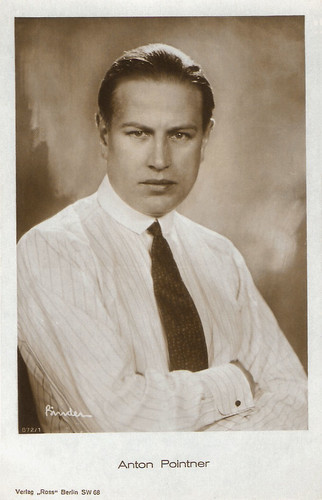
German postcard by Ross Verlag, Berlin, no. 872/1, 1925-1926. Photo: Alex Binder.
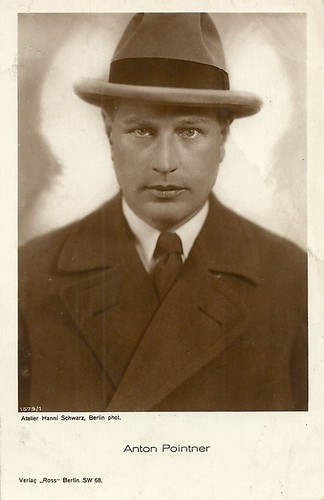
German postcard by Ross Verlag, Berlin, no. 1579/1, 1927-1928. Photo: Atelier Hanni Schwarz.
Powerful, robust characters in mostly supporting roles
Anton Pointner was born in 1890 in Salzburg. He got his first engagement in Lahr in 1907. His other theatre stations included Pilsen (Plzeň), Düsseldorf (1911) and Brno.
Pointner then worked in Vienna and from 1920 on in Berlin. He acted for example at the Lessing Theater and the State Theatre. His roles included the title character of 'Hamlet', Melchtal in 'Wilhelm Tell', and Prince Karl-Heinz in 'Alt-Heidelberg'.
In 1911, he made his screen debut in Lebensfreude/Enjoyment of life (Reinhard Bruck, 1911) with Polaire , and produced by Düsseldorfer Film-Manufaktur Ludwig Gottschalk. It was followed by Bruck's film Halbwelt/Demimonde (Reinhard Bruck, 1911).
Pointner did a few films in Vienna during the First World War. Yet, his film career really set off immediately after the war's end.
P, with whom he acted in the episode films Die Abenteurerin von Monte Carlo/The adventurer of Monte Carlo (Adolf Gärtner, 1921), Die Frau met den Millionen/The woman with the millions (Willi Wolff, 1922-23), and Der Flug um den Erdball/The flight around the globe (Willi Wolff, 1924-25).
They also co-starred in the single films Kopf hoch, Charly!/Cheer up, Charly! (Ludwig Wolff, 1926) and Die Frau ohne Nerven/The woman without nerves (Willi Wolff, 1929).
Around 1923 Pointner acted in several films by Friedrich Zelnik , in the mid-1920s also in films of the Dutch emigré directors Theo Frenkel (Frauenmoral/Female morality, 1923) and Jaap Speyer (Liebeshandel/ Love trade, 1926).
He co-acted with many female stars of Weimar cinema such as Ruth Weyher , Liane and Grit Haid, Magda Sonja , Anita Dorris , Claire Rommer, Maria Jacobini , Carmen Boni , Mary Carr, Lya De Putti, Asta Nielsen , Henny Porten, and many others.
The athletic actor embodied powerful, robust characters in mostly supporting roles, as Count Leicester in Maria Stuart/Mary Queen of Scots (Friedrich Fehér, 1927) and Frederick the Great's son and heir Friedrich Wilhelm in Der alte Fritz/The Old Fritz (Gerhard Lamprecht, 1927-1928).
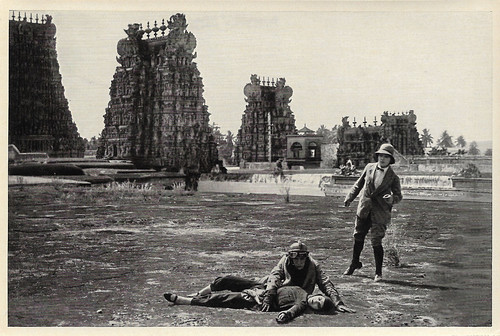
German collectors card by Ross Verlag in the series Vom Werden deutscher Filmkunst - Der Stumme Film, picture no. 66. Photo: Ellen-Richter-Film. Ellen Richter , Anton Pointner and Hans Brausewetter in Der flug um den Erdball/The flight around the globe (Willi Wolff, 1925).
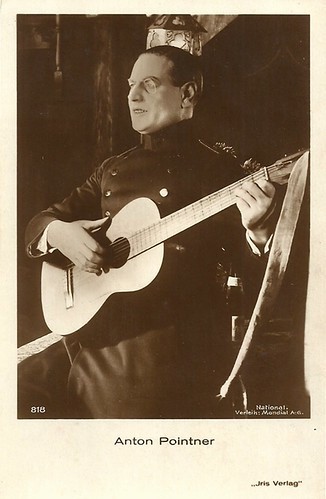
Austrian postcard by Iris Verlag, no. 818. Photo: National / Distr. Mondial. Anton Pointner in Die Sporck'schen Jäger/The Sporck Battalion (Holger-Madsen, 1927).
German versions of American films
In 1930-1931, Anton Pointner went to Hollywood and starred in German versions of American films, most of which were directed by William or Wilhelm Dieterle.
Pointner thus acted e.g. in Die heilige Flamme (Wilhelm Dieterle, Berthold Viertel, 1931), the German version of The Sacred Flame, and Menschen hinten Gittern (Pál Fejös, 1931), the German-language version of The Big House.
Returned to Germany in 1931 he easily started in the new sound film industry, e.g. in Trenck (Heinz Paul, Ernst Neubach, 1932), and Ich bei Tag und Du bei Nacht/I by day and you by night (Ludwig Berger, 1932).
At the time of the Third Reich in Germany, Pointner continued to be used in numerous productions such as the comedy Saison in Kairo/Cairo Season (1933) with Renate Müller and Willy Fritsch , and he portrayed e.g. the Austrian Emperor Franz I in Fridericus (Johannes Meyer, 1937) starring Otto Gebühr .
In 1939 he was briefly at the Cinecittà studios in Rome for the shooting of the German-Italian production Castelli in aria/Castles in the Air (Augusto Genina, 1939), starring Lilian Harvey and Vittorio De Sica.
After an intermission at war's end, Pointner continued his film acting from 1948. During a trip to Hintersee near Berchtesgaden, Anton Pointner died of a heart attack in 1949. His body was buried in the Salzburg municipal cemetery. His last three films were released after his death. All in all, he acted in 181 films.
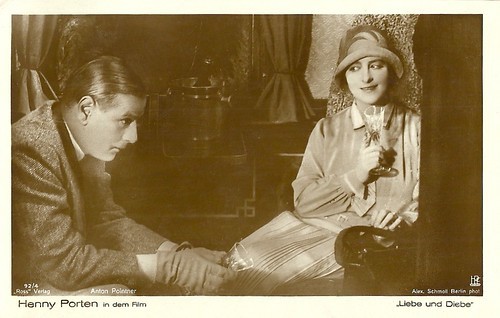
German postcard by Ross Verlag, no. 92/4. Photo: Henny Porten-Film / Photo Atelier Alex. Schmoll, Berlin. Henny Porten and Anton Pointner in the German silent romantic comedy Liebe und Diebe/Love and Thieves (Carl Froehlich, 1928).
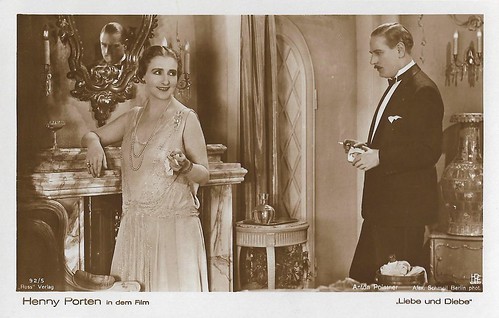
German postcard by Ross Verlag, no. 92/5. Photo: Henny Porten-Film / Photo Atelier Alex. Schmoll, Berlin. Henny Porten and Anton Pointner in the German silent romantic comedy Liebe und Diebe/Love and Thieves (Carl Froehlich, 1928).
Sources: Filmportal.de, Wikipedia (German and English), and .

German postcard by Ross Verlag, Berlin, no. 872/1, 1925-1926. Photo: Alex Binder.

German postcard by Ross Verlag, Berlin, no. 1579/1, 1927-1928. Photo: Atelier Hanni Schwarz.
Powerful, robust characters in mostly supporting roles
Anton Pointner was born in 1890 in Salzburg. He got his first engagement in Lahr in 1907. His other theatre stations included Pilsen (Plzeň), Düsseldorf (1911) and Brno.
Pointner then worked in Vienna and from 1920 on in Berlin. He acted for example at the Lessing Theater and the State Theatre. His roles included the title character of 'Hamlet', Melchtal in 'Wilhelm Tell', and Prince Karl-Heinz in 'Alt-Heidelberg'.
In 1911, he made his screen debut in Lebensfreude/Enjoyment of life (Reinhard Bruck, 1911) with Polaire , and produced by Düsseldorfer Film-Manufaktur Ludwig Gottschalk. It was followed by Bruck's film Halbwelt/Demimonde (Reinhard Bruck, 1911).
Pointner did a few films in Vienna during the First World War. Yet, his film career really set off immediately after the war's end.
P, with whom he acted in the episode films Die Abenteurerin von Monte Carlo/The adventurer of Monte Carlo (Adolf Gärtner, 1921), Die Frau met den Millionen/The woman with the millions (Willi Wolff, 1922-23), and Der Flug um den Erdball/The flight around the globe (Willi Wolff, 1924-25).
They also co-starred in the single films Kopf hoch, Charly!/Cheer up, Charly! (Ludwig Wolff, 1926) and Die Frau ohne Nerven/The woman without nerves (Willi Wolff, 1929).
Around 1923 Pointner acted in several films by Friedrich Zelnik , in the mid-1920s also in films of the Dutch emigré directors Theo Frenkel (Frauenmoral/Female morality, 1923) and Jaap Speyer (Liebeshandel/ Love trade, 1926).
He co-acted with many female stars of Weimar cinema such as Ruth Weyher , Liane and Grit Haid, Magda Sonja , Anita Dorris , Claire Rommer, Maria Jacobini , Carmen Boni , Mary Carr, Lya De Putti, Asta Nielsen , Henny Porten, and many others.
The athletic actor embodied powerful, robust characters in mostly supporting roles, as Count Leicester in Maria Stuart/Mary Queen of Scots (Friedrich Fehér, 1927) and Frederick the Great's son and heir Friedrich Wilhelm in Der alte Fritz/The Old Fritz (Gerhard Lamprecht, 1927-1928).

German collectors card by Ross Verlag in the series Vom Werden deutscher Filmkunst - Der Stumme Film, picture no. 66. Photo: Ellen-Richter-Film. Ellen Richter , Anton Pointner and Hans Brausewetter in Der flug um den Erdball/The flight around the globe (Willi Wolff, 1925).

Austrian postcard by Iris Verlag, no. 818. Photo: National / Distr. Mondial. Anton Pointner in Die Sporck'schen Jäger/The Sporck Battalion (Holger-Madsen, 1927).
German versions of American films
In 1930-1931, Anton Pointner went to Hollywood and starred in German versions of American films, most of which were directed by William or Wilhelm Dieterle.
Pointner thus acted e.g. in Die heilige Flamme (Wilhelm Dieterle, Berthold Viertel, 1931), the German version of The Sacred Flame, and Menschen hinten Gittern (Pál Fejös, 1931), the German-language version of The Big House.
Returned to Germany in 1931 he easily started in the new sound film industry, e.g. in Trenck (Heinz Paul, Ernst Neubach, 1932), and Ich bei Tag und Du bei Nacht/I by day and you by night (Ludwig Berger, 1932).
At the time of the Third Reich in Germany, Pointner continued to be used in numerous productions such as the comedy Saison in Kairo/Cairo Season (1933) with Renate Müller and Willy Fritsch , and he portrayed e.g. the Austrian Emperor Franz I in Fridericus (Johannes Meyer, 1937) starring Otto Gebühr .
In 1939 he was briefly at the Cinecittà studios in Rome for the shooting of the German-Italian production Castelli in aria/Castles in the Air (Augusto Genina, 1939), starring Lilian Harvey and Vittorio De Sica.
After an intermission at war's end, Pointner continued his film acting from 1948. During a trip to Hintersee near Berchtesgaden, Anton Pointner died of a heart attack in 1949. His body was buried in the Salzburg municipal cemetery. His last three films were released after his death. All in all, he acted in 181 films.

German postcard by Ross Verlag, no. 92/4. Photo: Henny Porten-Film / Photo Atelier Alex. Schmoll, Berlin. Henny Porten and Anton Pointner in the German silent romantic comedy Liebe und Diebe/Love and Thieves (Carl Froehlich, 1928).

German postcard by Ross Verlag, no. 92/5. Photo: Henny Porten-Film / Photo Atelier Alex. Schmoll, Berlin. Henny Porten and Anton Pointner in the German silent romantic comedy Liebe und Diebe/Love and Thieves (Carl Froehlich, 1928).
Sources: Filmportal.de, Wikipedia (German and English), and .
Published on April 25, 2021 22:00
April 24, 2021
Milva (1939-2021)
Italian singer, stage and film actress and television personality Milva (1939), a.k.a. 'La Rossa' (The Redhead), has died yesterday, 24 April 2021. Milva has triumphed on stages all over the world and received the highest honours. She was 81.
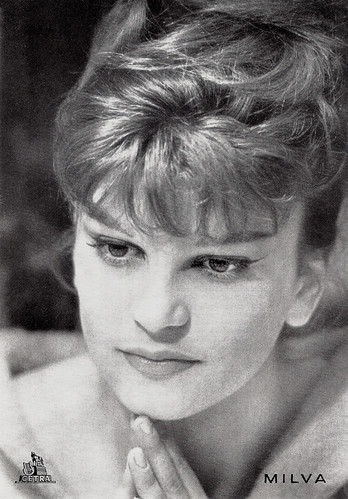
Italian promotion card by Dischi Cetra, Torino / Milano, 1964. Photo: Pietro Pascuttini, Roma.
The Panther of Goro
Milva was born as Maria Ilva Biolcati in Goro in the province of Ferrara in 1939.
In 1959, she won a contest for new voices and was named the overall winner from more than seven thousand six hundred participants. In 1960 she recorded her first 7" single with Cetra Records: Édith Piaf 's song 'Milord'.
Her real debut was on the stage of the Sanremo Music Festival in 1961, where she took third place. She has competed at the Festival a total of 15 times, the last time in 2007. The highest position she reached was second place in 1962. That year Milva was the first singer to perform Édith Piaf 's repertoire at the prestigious Olympia theatre in Paris.
In 1965, a fortunate meeting led to a definitive change in her career: Italian director Giorgio Strehler helped to develop her skills in staging and singing in Italian theatres (especially the Piccolo Teatro in Milan) and she began to perform a more committed repertoire (songs of the Italian resistance movement, songs from Bertolt Brecht's pieces, etc.).
In the following years, she starred in Giorgio Strehler's production of Brecht's 'The Threepenny Opera' which was performed in several cities of Western Europe. The press nicknamed her 'La Pantera di Goro’ (The Panther of Goro), and she is also known as 'La Rossa' (The Redhead), due to the colour of her hair.
Occasionally, she appeared in Italian films of the 1960s. Her film debut was the Musicarello Canzoni a tempo di twist/Songs in twist tempo (Stefano Canzio, 1962) with Tiberio Murgia.
In the comedy La bellezza di Ippolita/The Beautiful Ippolita (Giancarlo Zagni, 1963), she co-starred with Gina Lollobrigida . Later she appeared in the drama D'amore si muore/For Love One Dies (Carlo Carunchio, 1972) starring Silvana Mangano .
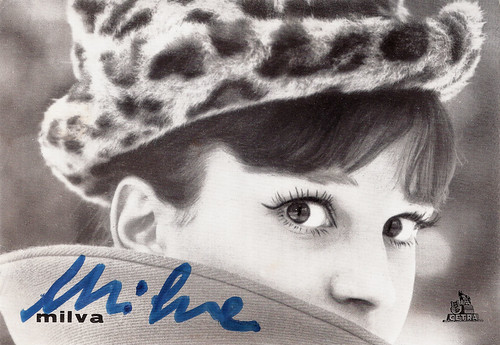
Italian promotion card by Dischi Cetra, Torino / Milano, no. 22, 1964. Photo: Pietro Pascuttini, Roma.
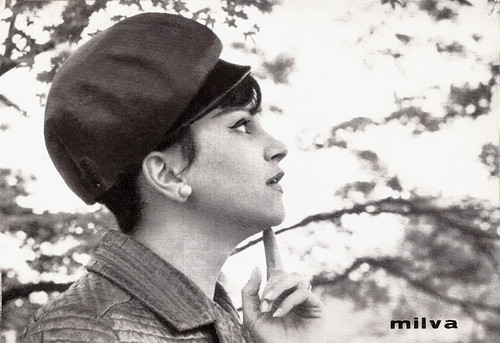
Italian promotion card by Dischi Cetra, Torino / Milano, no. 289, 1964.
Eclectic Artist
Milva is a highly eclectic artist. She performs both pop music and opera (in duet with Luciano Berio) but also plays in comedy, drama and musicals.
From 1973 to 1980, Milva was on tour with the band I Milvi. They toured through Italy, the USA, Greece, France, Germany, Canada, Russia and Japan. She collaborated with such European composers and musicians as Ennio Morricone in 1965, Francis Lai in 1973, Mikis Theodorakis in 1978 (their 'Was ich denke' became a bestselling album in Germany), Enzo Jannacci in 1980, Vangelis in 1981 and 1986, and Franco Battiato in 1982 and 1986.
Her stage productions of Bertolt Brecht's recitals and Luciano Berio's operas have toured the world's theatres. She has performed at La Scala in Milan, at the Deutsche Oper in Berlin, at the Paris Opera, in the Royal Albert Hall in London, at the 1984 Summer Olympics, at the Edinburgh Festival, and others.
She also returned to the big screen in the Italian drama Via degli specchi/Street of Mirrors (Giovanna Gagliardo, 1982) opposite Nicole Garcia. It was entered into the 33rd Berlin International Film Festival.
In 1983 she performed Édith Piaf 's repertoire again at the Olympia in Paris and again she received an ovation from the audience. The French press was very surprised how a non-French artist could interpret with such a feeling and energy the songs of Piaf.
She also hosted the TV show Al Paradise (Antonello Falqui, 1983-1985), which won the Rose d'Or (Golden Rose) of the Montreux Festival 1983. In 1984 she performed with Ástor Piazzolla the show El tango in the Les Bouffes du Nord Theatre in Paris. This was the beginning of a collaboration with Ástor Piazzolla, interpreting the nuevo tango.
She continued to play in films, including Mon beau-frère a tué ma soeur/My Brother-in-law Killed My Sister (Jacques Rouffio, 1987) with Michel Serrault and Michel Piccoli , Wherever You Are... (Krzysztof Zanussi, 1988) with Julian Sands, and Prisonnières/Women in Prison (Charlotte Silvera, 1988).
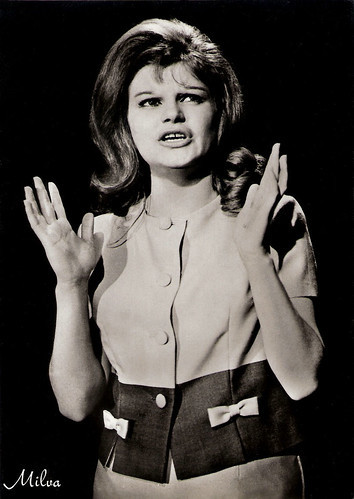
Italian postcard by Rotalfoto, Milano, no. 1067.
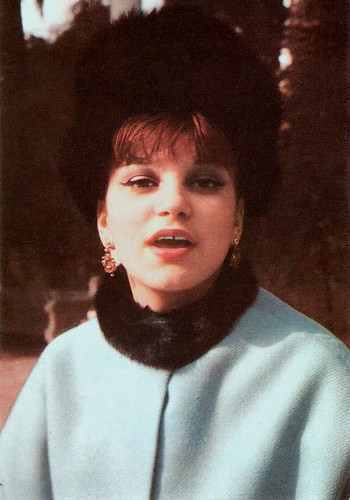
Italian postcard. Photo: Ricordi.
New inspiration
In 1997 Milva’s mentor Giorgio Strehler died. She temporarily reduced her theatre activities and focused on music only.
She received new inspiration collaborating with Thanos Mikroutsikos, James Last and Shinji Tanimura. Then she performed her fourteenth tour in Japan.
In 1998, she sang with Alexia Vassiliou on Alexia's album, 'Alexia - Mikis Theodorakis', a double album with new approaches to 26 Mikis Theodorakis compositions.
Milva remains to this day one of the most popular Italian personalities in the fields of music and theatre. But she still appears regularly in films too, such as Celluloide/Celluloid (Carlo Lizzani, 1995) with Giancarlo Giannini and Massimo Ghini, and Tod für fünf Stimmen/Death for Five Voices (Werner Herzog, 1996).
Later, she was also seen in the German TV series Liebesau - die andere Heimat/Liebesau - The other home (Wolfgang Panzer, 2001).
Her artistic stature has been officially recognised by the Italian, German and French republics, each of which has bestowed her with the highest honours. She was the only Italian artist in contemporary times, in fact, who was simultaneous: Chevalier of the National Order of the Legion of Honour of the French Republic (2009), Commander of the Order of Merit of the Italian Republic (2007), Officer of the Order of Merit of the Federal Republic of Germany Berlin, 2006 and Officier of the Ordre des Arts et des Lettres (1995).
Milva passed away on 24 April 2021 in Milano (Milan). She had a daughter, Martina, born during her marriage to Maurizio Corgnati in the early 1960s.
Milva sings 'Alexanderplatz' in 1986. Source: musikfan80 (YouTube).
Sources: Wikipedia and .

Italian promotion card by Dischi Cetra, Torino / Milano, 1964. Photo: Pietro Pascuttini, Roma.
The Panther of Goro
Milva was born as Maria Ilva Biolcati in Goro in the province of Ferrara in 1939.
In 1959, she won a contest for new voices and was named the overall winner from more than seven thousand six hundred participants. In 1960 she recorded her first 7" single with Cetra Records: Édith Piaf 's song 'Milord'.
Her real debut was on the stage of the Sanremo Music Festival in 1961, where she took third place. She has competed at the Festival a total of 15 times, the last time in 2007. The highest position she reached was second place in 1962. That year Milva was the first singer to perform Édith Piaf 's repertoire at the prestigious Olympia theatre in Paris.
In 1965, a fortunate meeting led to a definitive change in her career: Italian director Giorgio Strehler helped to develop her skills in staging and singing in Italian theatres (especially the Piccolo Teatro in Milan) and she began to perform a more committed repertoire (songs of the Italian resistance movement, songs from Bertolt Brecht's pieces, etc.).
In the following years, she starred in Giorgio Strehler's production of Brecht's 'The Threepenny Opera' which was performed in several cities of Western Europe. The press nicknamed her 'La Pantera di Goro’ (The Panther of Goro), and she is also known as 'La Rossa' (The Redhead), due to the colour of her hair.
Occasionally, she appeared in Italian films of the 1960s. Her film debut was the Musicarello Canzoni a tempo di twist/Songs in twist tempo (Stefano Canzio, 1962) with Tiberio Murgia.
In the comedy La bellezza di Ippolita/The Beautiful Ippolita (Giancarlo Zagni, 1963), she co-starred with Gina Lollobrigida . Later she appeared in the drama D'amore si muore/For Love One Dies (Carlo Carunchio, 1972) starring Silvana Mangano .

Italian promotion card by Dischi Cetra, Torino / Milano, no. 22, 1964. Photo: Pietro Pascuttini, Roma.

Italian promotion card by Dischi Cetra, Torino / Milano, no. 289, 1964.
Eclectic Artist
Milva is a highly eclectic artist. She performs both pop music and opera (in duet with Luciano Berio) but also plays in comedy, drama and musicals.
From 1973 to 1980, Milva was on tour with the band I Milvi. They toured through Italy, the USA, Greece, France, Germany, Canada, Russia and Japan. She collaborated with such European composers and musicians as Ennio Morricone in 1965, Francis Lai in 1973, Mikis Theodorakis in 1978 (their 'Was ich denke' became a bestselling album in Germany), Enzo Jannacci in 1980, Vangelis in 1981 and 1986, and Franco Battiato in 1982 and 1986.
Her stage productions of Bertolt Brecht's recitals and Luciano Berio's operas have toured the world's theatres. She has performed at La Scala in Milan, at the Deutsche Oper in Berlin, at the Paris Opera, in the Royal Albert Hall in London, at the 1984 Summer Olympics, at the Edinburgh Festival, and others.
She also returned to the big screen in the Italian drama Via degli specchi/Street of Mirrors (Giovanna Gagliardo, 1982) opposite Nicole Garcia. It was entered into the 33rd Berlin International Film Festival.
In 1983 she performed Édith Piaf 's repertoire again at the Olympia in Paris and again she received an ovation from the audience. The French press was very surprised how a non-French artist could interpret with such a feeling and energy the songs of Piaf.
She also hosted the TV show Al Paradise (Antonello Falqui, 1983-1985), which won the Rose d'Or (Golden Rose) of the Montreux Festival 1983. In 1984 she performed with Ástor Piazzolla the show El tango in the Les Bouffes du Nord Theatre in Paris. This was the beginning of a collaboration with Ástor Piazzolla, interpreting the nuevo tango.
She continued to play in films, including Mon beau-frère a tué ma soeur/My Brother-in-law Killed My Sister (Jacques Rouffio, 1987) with Michel Serrault and Michel Piccoli , Wherever You Are... (Krzysztof Zanussi, 1988) with Julian Sands, and Prisonnières/Women in Prison (Charlotte Silvera, 1988).

Italian postcard by Rotalfoto, Milano, no. 1067.

Italian postcard. Photo: Ricordi.
New inspiration
In 1997 Milva’s mentor Giorgio Strehler died. She temporarily reduced her theatre activities and focused on music only.
She received new inspiration collaborating with Thanos Mikroutsikos, James Last and Shinji Tanimura. Then she performed her fourteenth tour in Japan.
In 1998, she sang with Alexia Vassiliou on Alexia's album, 'Alexia - Mikis Theodorakis', a double album with new approaches to 26 Mikis Theodorakis compositions.
Milva remains to this day one of the most popular Italian personalities in the fields of music and theatre. But she still appears regularly in films too, such as Celluloide/Celluloid (Carlo Lizzani, 1995) with Giancarlo Giannini and Massimo Ghini, and Tod für fünf Stimmen/Death for Five Voices (Werner Herzog, 1996).
Later, she was also seen in the German TV series Liebesau - die andere Heimat/Liebesau - The other home (Wolfgang Panzer, 2001).
Her artistic stature has been officially recognised by the Italian, German and French republics, each of which has bestowed her with the highest honours. She was the only Italian artist in contemporary times, in fact, who was simultaneous: Chevalier of the National Order of the Legion of Honour of the French Republic (2009), Commander of the Order of Merit of the Italian Republic (2007), Officer of the Order of Merit of the Federal Republic of Germany Berlin, 2006 and Officier of the Ordre des Arts et des Lettres (1995).
Milva passed away on 24 April 2021 in Milano (Milan). She had a daughter, Martina, born during her marriage to Maurizio Corgnati in the early 1960s.
Milva sings 'Alexanderplatz' in 1986. Source: musikfan80 (YouTube).
Sources: Wikipedia and .
Published on April 24, 2021 22:00
April 23, 2021
Thomas Fritsch (1944-2021)
On 21 April 2021, German actor Thomas Fritsch (1944) passed away. The son of ‘Sunny boy’ Willy Fritsch was a teen idol of the early 1960s who made several light entertainment films and recorded popular Schlagers. He also appeared on stage and TV and as a voice actor, he dubbed many Hollywood blockbusters in German. He was 77.
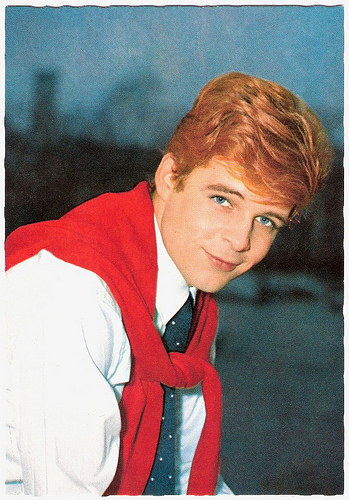
German postcard by ISV, no. K 26. Photo: Erwin Schneider.
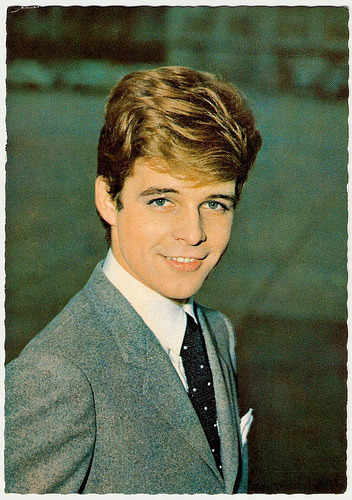
German postcard by ISV, no. K 27. Photo: Erwin Schneider.
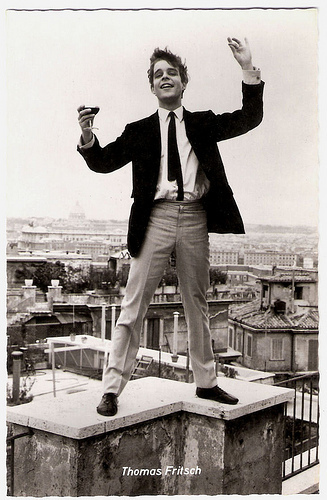
German postcard by Kolibri, no. 2007.
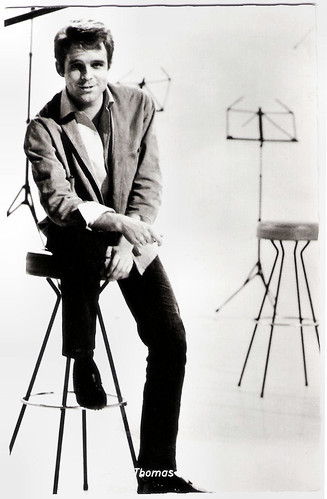
German Kolibri postcard by Friedrich W. Sander-Verlag, Minden/Westf., no. 2650. Photo: Lothar Winkler.
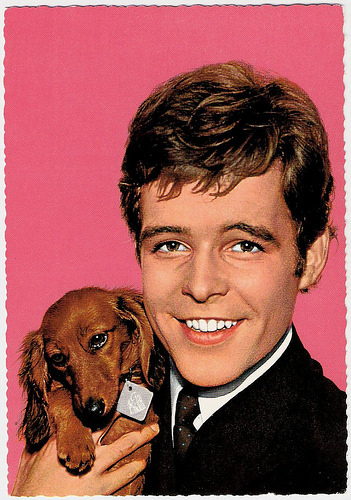
German postcard by Krüger, no. 902/371. Photo: Polygram / Yüksel.
I Learned It from Father
Thomas Fritsch was born in Dresden, Germany in 1944. He is the son of the legendary Ufa star Willy Fritsch and the dancer and actress Dinah Grace (aka Ilse Schmidt). He has a brother, Michael.
When the war ended, the family fled to Hamburg. Actor and director Gustaf Gründgens advised 16-year-old Thomas to become an actor. So after high school, Fritsch studied with Eduard Marks, the head of the drama class of the Hochschule für Musik und Theater (University of Music and Theatre) in Hamburg. He also took singing and ballet lessons.
In 1960 he was discovered for the screen and made his debut in Das gibt's doch zweimal/That can be done twice (1960) with Gus Backus and his father Willy Fritsch .
He played the son of Lilli Palmer in the Austrian comedy Julia, Du bist zauberhaft/Adorable Julia (Alfred Weidenmann, 1962), which was entered into the 1962 Cannes Film Festival.
Other well-known films are Das schwarz-weiß-rote Himmelbett/Black-White-Red Four Poster (Rolf Thiele, 1962) with Daliah Lavi , and Das große Liebesspiel/And So to Bed (Alfred Weidenmann, 1963) with Lilli Palmer .
Thomas was also the singer of Schlagers as 'Dreamy Girl'. The teenager idol appeared on many covers of the popular German youth magazine Bravo. Weekly, he received 2.000 letters from his mostly female fans.
Together with his famous father, he co-starred in Das hab ich von Papa gelernt/I Learned It from Father (Axel von Ambesser, 1964). But in the following years, his film career went downhill and the dream of a Hollywood career became a deception.
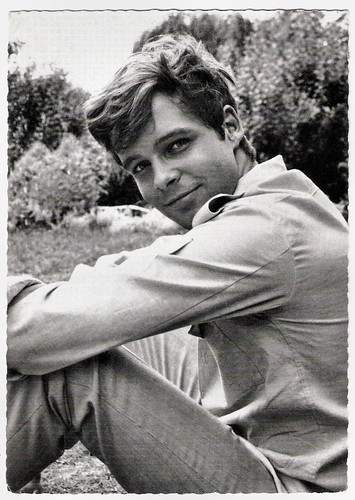
German postcard by Filmbilder-Vertrieb Ernst Freihoff, Essen, no. 841. Photo: Lothar Winkler.

German postcard by Filmbilder-Vertrieb Ernst Freihoff, Essen, no. 842. Photo: Lothar Winkler.
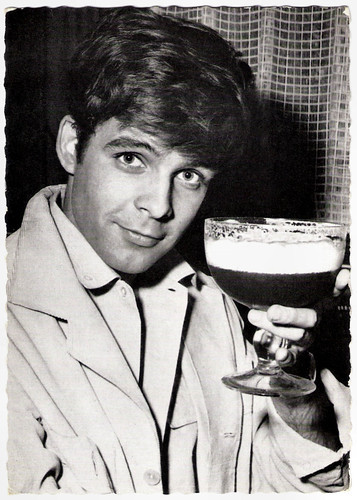
German postcard by Filmbilder-Vertrieb Ernst Freihoff, Essen, no. 843. Photo: Lothar Winkler.
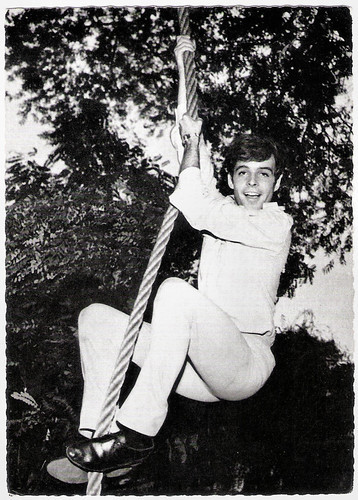
German postcard by Filmbilder-Vertrieb Ernst Freihoff, Essen, no. 850. Photo: Lothar Winkler.
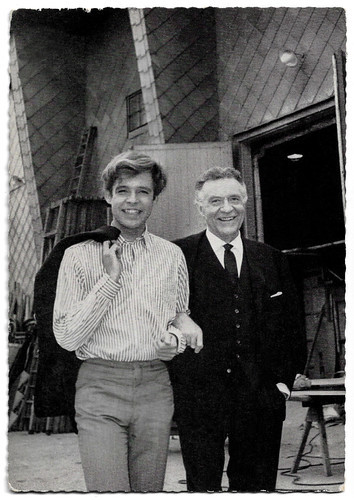
German postcard by Filmbilder-Vertrieb Ernst Freihoff, Essen, no. 889. Photo: Lothar Winkler. Thomas Fritsch and his father, Willy Fritsch .
The voice of Scar
After his days as a teen idol were over, Thomas Fritsch focused on a stage career. In 1964, he already had made his stage debut in G.B. Shaw's 'Candida' at the Stadttheater Heidelberg. In 1965, the Frankfurter Kleinen Theater am Zoo engaged him and later followed engagements at other stage companies in Munich, Berlin, Stuttgart, and Hamburg.
On TV, he was seen in many series including episodes of popular Krimi series like Der Kommissar (1970-1975) and Derrick (1974-1989).
From the 1990s on, Fritsch was a busy voice actor, who dubbed many American actors for the German versions of their films. Among the films he gave his voice to are such blockbusters as The Three Musketeers (Stephen Herek, 1993), Die Hard with a Vengeance (John McTiernan, 1995), Titanic (James Cameron, 1997), Gladiator (Ridley Scott, 2000), Harry Potter and the Philosopher's Stone (Chris Columbus, 2001), Master and Commander: The Far Side of the World (Peter Weir, 2003), The Lord of the Rings: The Return of the King (Peter Jackson, 2003), Kingdom of Heaven (Ridley Scott, 2005) and The Dark Knight (Christopher Nolan, 2008).
One of his best-remembered dubs was the voice of Scar in the German version of The Lion King (Roger Allers, Rob Minkoff, 1994). Since then, he voiced many other animated animals in such hits as Ice Age (Chris Wedge, Carlos Saldanha, 2002), Finding Nemo (Andrew Stanton, Lee Unkrich, 2003), and Ice Age: The Meltdown (Carlos Saldanha, 2006).
Fritsch also gave his voice to such hit series as The Nanny (1993–1999) and South Park (2003).
He also could be seen in films like the Edgar Wallace satire Der Wixxer/The Trixxer (Tobi Baumann, 2004) as the Earl of Cockwood, and the fantasy Mara und der Feuerbringer/Mara and the fire bringer (Tommy Krappweis, 2014).
Thomas Fritsch lived in Munich, Germany, and on the Greek isle of Mykonos. Most of the sources didn't have more information about Fritsch's private life than that he was an active animal rights activist and that he loved his mother. For those readers who might think his song 'Schau mich bi' had a deeper meaning: the confirmed bachelor denied in 1991 firmly he's gay. However, in 1996, Fritsch confessed he was bisexual.
Thomas Fritsch died on 21 April 2021 at the age of 77, after having last lived in a retirement home.
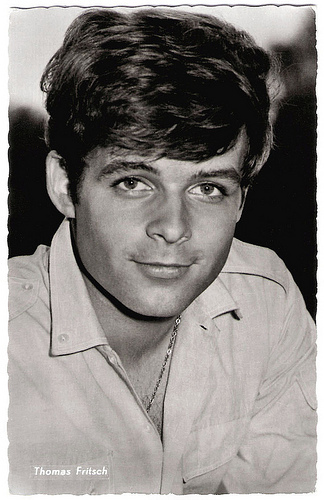
German postcard by Filmbilder-Vertrieb Ernst Freihoff, Essen, no. AX 5758. Photo: Lothar Winkler.
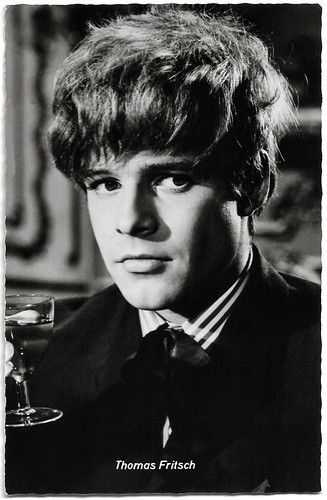
German Kolibri postcard by Friedrich W. Sander-Verlag, Minden/Westf., no. 2151. Photo: Stedthalle / Berolina / Kurt Ulrich / Nora. Thomas Fritsch in Das hab ich von Papa gelernt/I Learned It from Father (Axel von Ambesser, 1964).
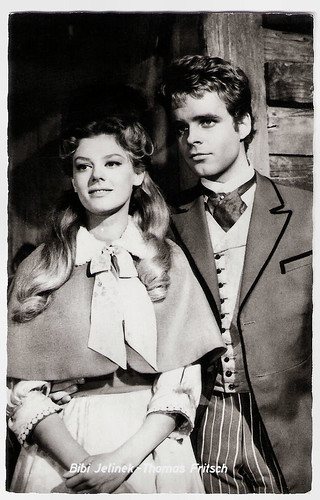
German Kolibri postcard by Friedrich W. Sander-Verlag, Minden/Westf., no. 2344. Photo: Berneis / Nora. Bibi Jelinek and Thomas Fritsch in Onkel Toms Hütte/Uncle Tom's Cabin (Géza von Radványi, 1965).

German German promotion card. Photo: Hans J. Hoffmann, Frankfurt.
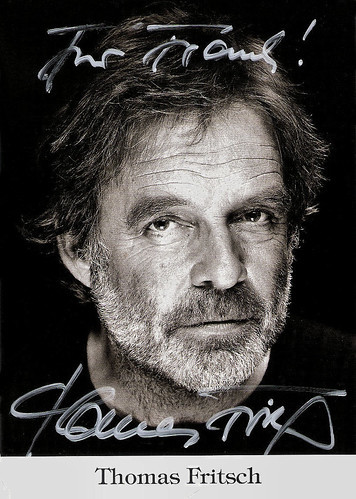
German autograph card.
Sources: Stephanie D'heil (Steffi-Line - German), Wikipedia (German and English), and .

German postcard by ISV, no. K 26. Photo: Erwin Schneider.

German postcard by ISV, no. K 27. Photo: Erwin Schneider.

German postcard by Kolibri, no. 2007.

German Kolibri postcard by Friedrich W. Sander-Verlag, Minden/Westf., no. 2650. Photo: Lothar Winkler.

German postcard by Krüger, no. 902/371. Photo: Polygram / Yüksel.
I Learned It from Father
Thomas Fritsch was born in Dresden, Germany in 1944. He is the son of the legendary Ufa star Willy Fritsch and the dancer and actress Dinah Grace (aka Ilse Schmidt). He has a brother, Michael.
When the war ended, the family fled to Hamburg. Actor and director Gustaf Gründgens advised 16-year-old Thomas to become an actor. So after high school, Fritsch studied with Eduard Marks, the head of the drama class of the Hochschule für Musik und Theater (University of Music and Theatre) in Hamburg. He also took singing and ballet lessons.
In 1960 he was discovered for the screen and made his debut in Das gibt's doch zweimal/That can be done twice (1960) with Gus Backus and his father Willy Fritsch .
He played the son of Lilli Palmer in the Austrian comedy Julia, Du bist zauberhaft/Adorable Julia (Alfred Weidenmann, 1962), which was entered into the 1962 Cannes Film Festival.
Other well-known films are Das schwarz-weiß-rote Himmelbett/Black-White-Red Four Poster (Rolf Thiele, 1962) with Daliah Lavi , and Das große Liebesspiel/And So to Bed (Alfred Weidenmann, 1963) with Lilli Palmer .
Thomas was also the singer of Schlagers as 'Dreamy Girl'. The teenager idol appeared on many covers of the popular German youth magazine Bravo. Weekly, he received 2.000 letters from his mostly female fans.
Together with his famous father, he co-starred in Das hab ich von Papa gelernt/I Learned It from Father (Axel von Ambesser, 1964). But in the following years, his film career went downhill and the dream of a Hollywood career became a deception.

German postcard by Filmbilder-Vertrieb Ernst Freihoff, Essen, no. 841. Photo: Lothar Winkler.

German postcard by Filmbilder-Vertrieb Ernst Freihoff, Essen, no. 842. Photo: Lothar Winkler.

German postcard by Filmbilder-Vertrieb Ernst Freihoff, Essen, no. 843. Photo: Lothar Winkler.

German postcard by Filmbilder-Vertrieb Ernst Freihoff, Essen, no. 850. Photo: Lothar Winkler.

German postcard by Filmbilder-Vertrieb Ernst Freihoff, Essen, no. 889. Photo: Lothar Winkler. Thomas Fritsch and his father, Willy Fritsch .
The voice of Scar
After his days as a teen idol were over, Thomas Fritsch focused on a stage career. In 1964, he already had made his stage debut in G.B. Shaw's 'Candida' at the Stadttheater Heidelberg. In 1965, the Frankfurter Kleinen Theater am Zoo engaged him and later followed engagements at other stage companies in Munich, Berlin, Stuttgart, and Hamburg.
On TV, he was seen in many series including episodes of popular Krimi series like Der Kommissar (1970-1975) and Derrick (1974-1989).
From the 1990s on, Fritsch was a busy voice actor, who dubbed many American actors for the German versions of their films. Among the films he gave his voice to are such blockbusters as The Three Musketeers (Stephen Herek, 1993), Die Hard with a Vengeance (John McTiernan, 1995), Titanic (James Cameron, 1997), Gladiator (Ridley Scott, 2000), Harry Potter and the Philosopher's Stone (Chris Columbus, 2001), Master and Commander: The Far Side of the World (Peter Weir, 2003), The Lord of the Rings: The Return of the King (Peter Jackson, 2003), Kingdom of Heaven (Ridley Scott, 2005) and The Dark Knight (Christopher Nolan, 2008).
One of his best-remembered dubs was the voice of Scar in the German version of The Lion King (Roger Allers, Rob Minkoff, 1994). Since then, he voiced many other animated animals in such hits as Ice Age (Chris Wedge, Carlos Saldanha, 2002), Finding Nemo (Andrew Stanton, Lee Unkrich, 2003), and Ice Age: The Meltdown (Carlos Saldanha, 2006).
Fritsch also gave his voice to such hit series as The Nanny (1993–1999) and South Park (2003).
He also could be seen in films like the Edgar Wallace satire Der Wixxer/The Trixxer (Tobi Baumann, 2004) as the Earl of Cockwood, and the fantasy Mara und der Feuerbringer/Mara and the fire bringer (Tommy Krappweis, 2014).
Thomas Fritsch lived in Munich, Germany, and on the Greek isle of Mykonos. Most of the sources didn't have more information about Fritsch's private life than that he was an active animal rights activist and that he loved his mother. For those readers who might think his song 'Schau mich bi' had a deeper meaning: the confirmed bachelor denied in 1991 firmly he's gay. However, in 1996, Fritsch confessed he was bisexual.
Thomas Fritsch died on 21 April 2021 at the age of 77, after having last lived in a retirement home.

German postcard by Filmbilder-Vertrieb Ernst Freihoff, Essen, no. AX 5758. Photo: Lothar Winkler.

German Kolibri postcard by Friedrich W. Sander-Verlag, Minden/Westf., no. 2151. Photo: Stedthalle / Berolina / Kurt Ulrich / Nora. Thomas Fritsch in Das hab ich von Papa gelernt/I Learned It from Father (Axel von Ambesser, 1964).

German Kolibri postcard by Friedrich W. Sander-Verlag, Minden/Westf., no. 2344. Photo: Berneis / Nora. Bibi Jelinek and Thomas Fritsch in Onkel Toms Hütte/Uncle Tom's Cabin (Géza von Radványi, 1965).

German German promotion card. Photo: Hans J. Hoffmann, Frankfurt.

German autograph card.
Sources: Stephanie D'heil (Steffi-Line - German), Wikipedia (German and English), and .
Published on April 23, 2021 22:00
April 22, 2021
James Stewart
American actor James Stewart (1908-1997) is among the most honored and popular stars in film history. Known for his distinctive drawl and everyman screen persona, Stewart had a film career that spanned over 55 years and 80 films.
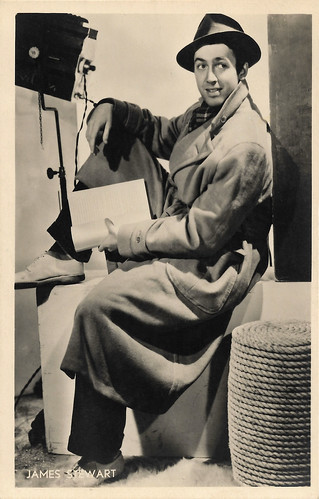
Dutch postcard by S. & v. H., A. Photo: M.P.E.A.
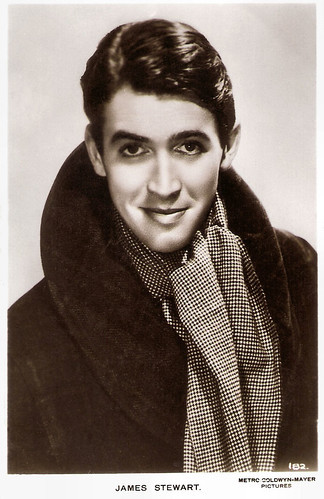
British "Real Photograph" postcard, no. 182. Photo: Metro Goldwyn Mayer.
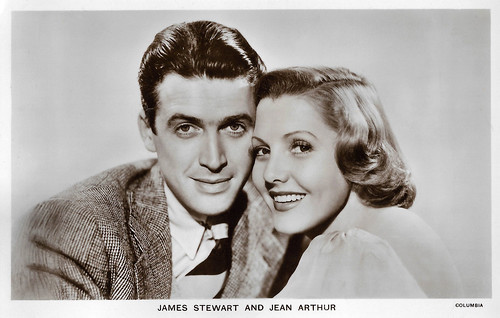
British postcard in the Film Partners Series, London, no. P 265. Photo: Columbia. James Stewart and Jean Arthur in You Can't Take It with You (Frank Capra, 1938).
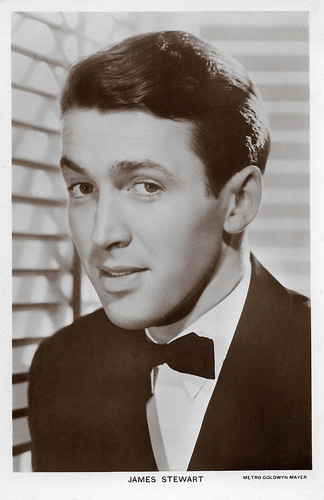
British postcard in the Picturegoer Series, London, no. 1214a (a former owner wrote: 1080A). Photo: Metro-Goldwyn-Mayer.
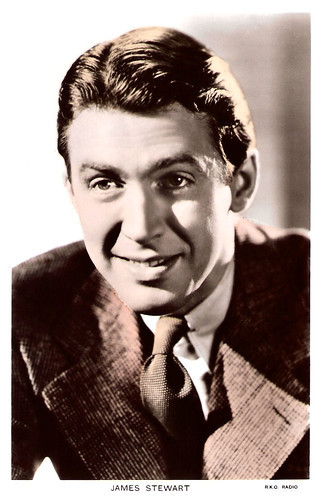
British Handcoloured Real Photograph postcard in the Colourgraph Series, London, no. C 303 Photo: R.K.O. Radio.
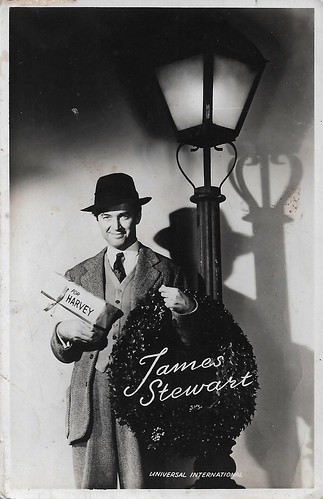
Dutch postcard. Photo: Universal International. James Stewart in Harvey (Henry Koster, 1950).
A screen persona as the likable "everyman"
James Maitland Stewart was born in 1908, in Indiana, Pennsylvania. His parents were Elizabeth Ruth (Johnson) and Alexander Maitland Stewart, who owned a hardware store. 'Jimmy' was educated at a local prep school, Mercersburg Academy, where he was a keen athlete (football and track), musician (singing and accordion playing), and sometime actor.
In 1929, he won a place at Princeton University. Stewart graduated from Princeton in 1932 with a degree in architecture. He then became part of the University Players, a summer stock company in Falmouth, Massachusetts. There he met Henry Fonda , and the two became lifelong friends. He appeared on Broadway and in summer stock productions. Work dried up as the Great Depression deepened, and it was not until 1934, when he followed Fonda to Hollywood, that things began to pick up.
In 1935, he signed a film contract with Metro-Goldwyn-Mayer (MGM). He made his film debut in The Murder Man (Tim Whelan, 1935) with Spencer Tracy. The studio did not see leading man material in Stewart, but after three years of supporting roles and being loaned out to other studios, he had his big breakthrough in Frank Capra's ensemble comedy You Can't Take It with You (1938) at Columbia.
Adapted from the Pulitzer Prize-winning play of the same name by George S. Kaufman and Moss Hart, You Can't Take It with You is about a man (Stewart) from a family of rich snobs who becomes engaged to a woman (Jean Arthur) from a good-natured but decidedly eccentric family. Stewart's unpretentious engaging manner, led to quick acceptance by the moviegoing public.
The following year, Stewart got his first Oscar nomination for his portrayal of a shy idealistic young senator fighting corruption in Congress in Capra's Mr. Smith Goes to Washington (Frank Capra, 1939), again opposite Jean Arthur. These roles established his screen persona as the likable "everyman". He won the Academy Award for his work in the screwball comedy The Philadelphia Story (George Cukor, 1940), which also starred Katharine Hepburn and Cary Grant .
A licensed amateur pilot, Stewart enlisted as a private in the Army Air Corps as soon as he could after the United States entered the Second World War in 1941. Although still an MGM star, his only public and film appearances in 1941—1945 were scheduled by the Air Corps. After fighting in the European theater of war, he had attained the rank of colonel and had received several awards for his service. He remained in the U.S. Air Force Reserve and was promoted to brigadier general in 1959. He retired in 1968 and was awarded the United States Air Force Distinguished Service Medal.
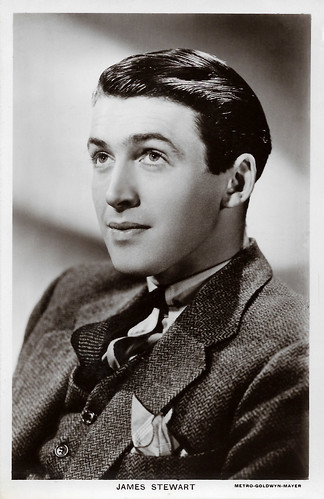
British postcard in the Picturegoer Series, London, no. 1080. Photo: Metro-Goldwyn-Mayer.
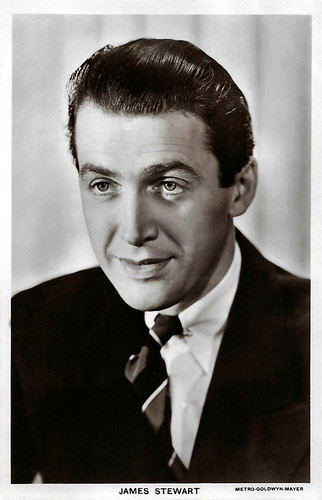
British postcard in the Picturegoer Series, London, no. 1214a. Photo: Metro-Goldwyn-Mayer.
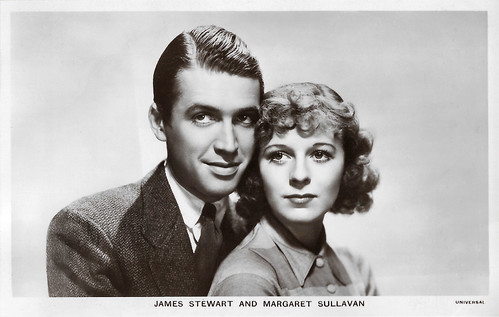
British postcard in the Film Partners Seriesm London, no. P 199. Photo: Universal. James Stewart and Margaret Sullavan in Next Time We Love (1936).
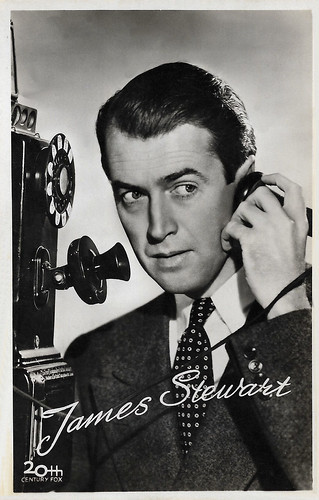
Dutch postcard by Fotoarchief Film en Toneel, no. 3440. Photo: 20th Century Fox. James Stewart in Call Northside 777 (Henry Hathaway, 1948).
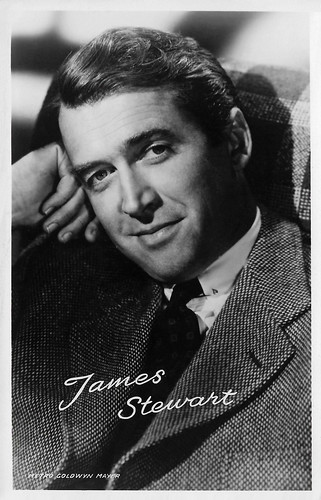
Dutch postcard. Photo: Metro Goldwyn Mayer.
A career revival by playing darker, more morally ambiguous characters
After the war, James Stewart had difficulties in adapting to a changing Hollywood and even thought about ending his acting career. He became a freelancer, and had his first post-war role was as George Bailey in Capra's It's a Wonderful Life (Frank Capra, 1946) with Donna Reed .
It earned Stewart his third Oscar nomination, but It's a Wonderful Life was not a big success at first. Now it is seen as one of the most beloved films of all time, largely because of its numerous television showings since the 1970s.
In the 1950s, Stewart experienced a career revival by playing darker, more morally ambiguous characters in Westerns and thrillers. His collaborations with directors Alfred Hitchcock and Anthony Mann helped toughen his image and broaden his appeal.
With Alfred Hitchcock , he collaborated on Rope (1948), Rear Window (1954), The Man Who Knew Too Much (1956), and Vertigo (1958) with Kim Novak. Vertigo was ignored by critics at its time of release, but has since been reevaluated and recognised as an American cinematic masterpiece. Britannica: "For Hitchcock, Stewart embodied an American Everyman, albeit one whose private quirks and obsessions threatened a tragic outcome."
With Anthony Mann, he made eight films including The Western Winchester '73 (1950), the sentimental biopic The Glenn Miller Story (1954), and the Western The Naked Spur (1953). Following the release of Winchester '73 (1950), he appeared on the list of Top 10 Stars at the US box office for the first time, a position he retained until the end of the decade.
His other films in the 1950s included the Broadway adaptation Harvey (Henry Koster, 1950) and the courtroom drama Anatomy of a Murder (Otto Preminger, 1959), both of which landed him Oscar nominations. He was one of the most popular film stars of the decade, with most of his films becoming box office successes.
Stewart's later Westerns included The Man Who Shot Liberty Valance (1962) and Cheyenne Autumn (1964), both directed by John Ford. He signed a lucrative multi-movie deal with 20th Century-Fox in 1962 and appeared in many popular family comedies during the decade.
After a brief venture into television acting, Stewart semi-retired by the 1980s, although he remained a public figure due to the renewed interest in his films with Capra and Hitchcock and his appearances at President Reagan's White House. He received many honorary awards, including an honorary Academy Honorary Award and the Presidential Medal of Freedom, both in 1985.
Stewart remained unmarried until his 40s and was dubbed "The Great American Bachelor" by the press. In 1949, he married former model Gloria Hatrick McLean. They had twin daughters, and he adopted her two sons from her previous marriage. His adopted son Ronnie was killed in Vietnam. The marriage lasted until McLean's death in 1994. James Stewart died of a pulmonary embolism three years later in Beverly Hills. His last words to his family were, "I'm going to be with Gloria now".
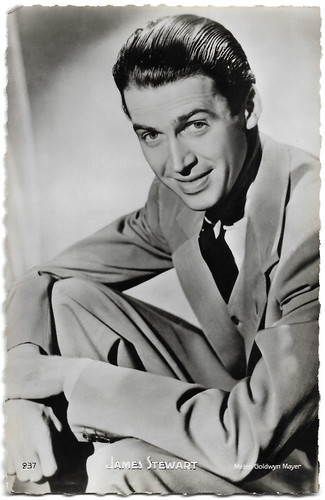
French postcard by Editions P.I., Paris, for S.A. Victoria, Brussels, no. 237. Photo: Metro-Goldwyn-Mayer, 1950.
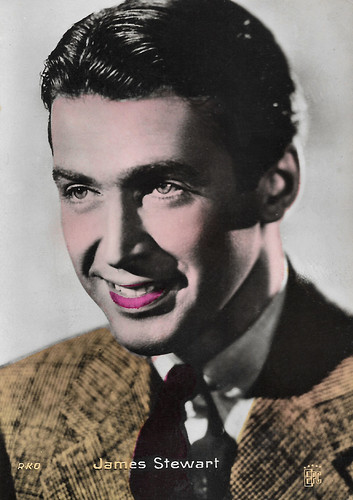
French card by EPC. Photo: RKO.
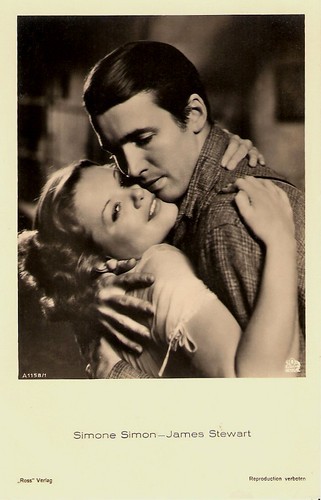
German postcard by Ross Verlag, no. A 1158/1, 1937-1938. Photo: 20th Century Fox. Simone Simon and James Stewart in Seventh Heaven (Henry King. 1937).
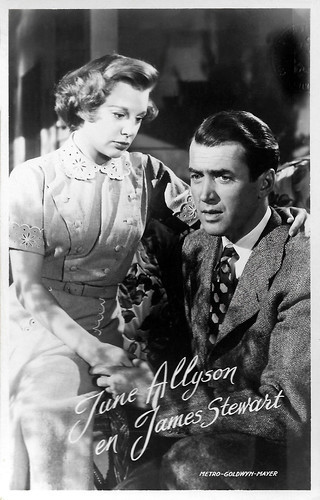
Dutch postcard, no. a.x. 253. Photo: Metro-Goldwyn-Mayer. June Allyson and James Stewart in The Stratton Story (Sam Wood, 1949).
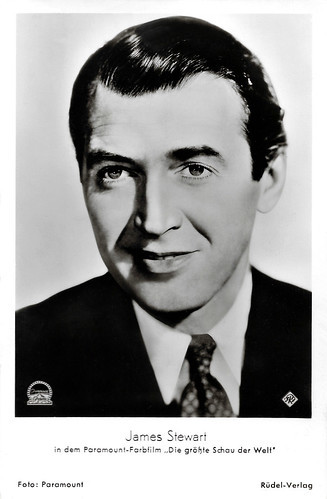
German postcard by Rüdel-Verlag, Hamburg-Bergedorf, no. 397. Photo: Paramount. James Stewart in The Greatest Show on Earth (Cecil B. DeMille, 1952).
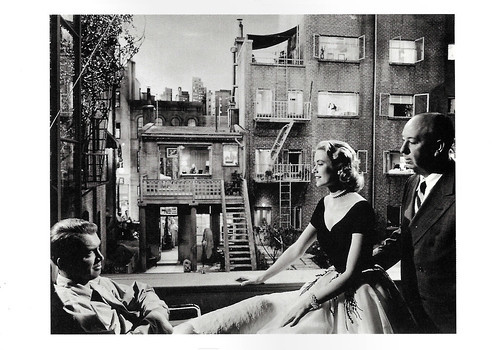
French postcard in the Collection Magie Noire nu Editions Hazan, Paris, no. 6490, 1996. James Stewart, Grace Kelly and Alfred Hitchcock at the set of Rear Window (Alfred Hitchcock, 1954).
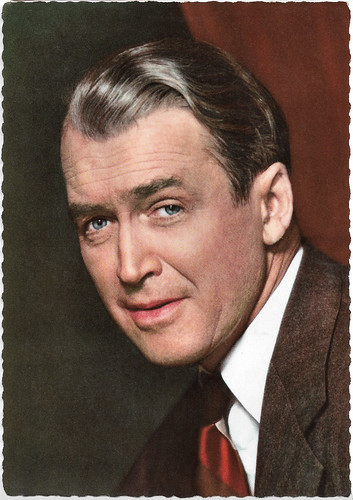
Belgian postcard by Edition H. Troukens, Hofstade, licence holder for Universum-Film Aktiengesellschaft (UFA), Berlin-Tempelhof, no. 1037. Photo: UFA.
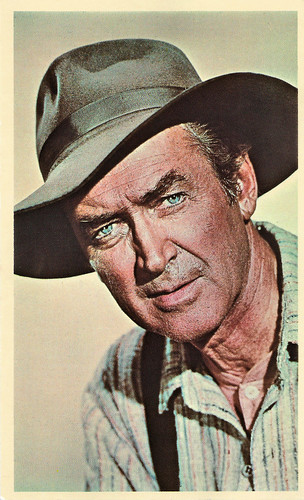
American postcard by Universal Pictures Company, Inc., 1965. Photo: Universal. James Stewart in Shenandoah (Andrew V. McLaglen, 1965).
Source: Britannica, Wikipedia, and .

Dutch postcard by S. & v. H., A. Photo: M.P.E.A.

British "Real Photograph" postcard, no. 182. Photo: Metro Goldwyn Mayer.

British postcard in the Film Partners Series, London, no. P 265. Photo: Columbia. James Stewart and Jean Arthur in You Can't Take It with You (Frank Capra, 1938).

British postcard in the Picturegoer Series, London, no. 1214a (a former owner wrote: 1080A). Photo: Metro-Goldwyn-Mayer.

British Handcoloured Real Photograph postcard in the Colourgraph Series, London, no. C 303 Photo: R.K.O. Radio.

Dutch postcard. Photo: Universal International. James Stewart in Harvey (Henry Koster, 1950).
A screen persona as the likable "everyman"
James Maitland Stewart was born in 1908, in Indiana, Pennsylvania. His parents were Elizabeth Ruth (Johnson) and Alexander Maitland Stewart, who owned a hardware store. 'Jimmy' was educated at a local prep school, Mercersburg Academy, where he was a keen athlete (football and track), musician (singing and accordion playing), and sometime actor.
In 1929, he won a place at Princeton University. Stewart graduated from Princeton in 1932 with a degree in architecture. He then became part of the University Players, a summer stock company in Falmouth, Massachusetts. There he met Henry Fonda , and the two became lifelong friends. He appeared on Broadway and in summer stock productions. Work dried up as the Great Depression deepened, and it was not until 1934, when he followed Fonda to Hollywood, that things began to pick up.
In 1935, he signed a film contract with Metro-Goldwyn-Mayer (MGM). He made his film debut in The Murder Man (Tim Whelan, 1935) with Spencer Tracy. The studio did not see leading man material in Stewart, but after three years of supporting roles and being loaned out to other studios, he had his big breakthrough in Frank Capra's ensemble comedy You Can't Take It with You (1938) at Columbia.
Adapted from the Pulitzer Prize-winning play of the same name by George S. Kaufman and Moss Hart, You Can't Take It with You is about a man (Stewart) from a family of rich snobs who becomes engaged to a woman (Jean Arthur) from a good-natured but decidedly eccentric family. Stewart's unpretentious engaging manner, led to quick acceptance by the moviegoing public.
The following year, Stewart got his first Oscar nomination for his portrayal of a shy idealistic young senator fighting corruption in Congress in Capra's Mr. Smith Goes to Washington (Frank Capra, 1939), again opposite Jean Arthur. These roles established his screen persona as the likable "everyman". He won the Academy Award for his work in the screwball comedy The Philadelphia Story (George Cukor, 1940), which also starred Katharine Hepburn and Cary Grant .
A licensed amateur pilot, Stewart enlisted as a private in the Army Air Corps as soon as he could after the United States entered the Second World War in 1941. Although still an MGM star, his only public and film appearances in 1941—1945 were scheduled by the Air Corps. After fighting in the European theater of war, he had attained the rank of colonel and had received several awards for his service. He remained in the U.S. Air Force Reserve and was promoted to brigadier general in 1959. He retired in 1968 and was awarded the United States Air Force Distinguished Service Medal.

British postcard in the Picturegoer Series, London, no. 1080. Photo: Metro-Goldwyn-Mayer.

British postcard in the Picturegoer Series, London, no. 1214a. Photo: Metro-Goldwyn-Mayer.

British postcard in the Film Partners Seriesm London, no. P 199. Photo: Universal. James Stewart and Margaret Sullavan in Next Time We Love (1936).

Dutch postcard by Fotoarchief Film en Toneel, no. 3440. Photo: 20th Century Fox. James Stewart in Call Northside 777 (Henry Hathaway, 1948).

Dutch postcard. Photo: Metro Goldwyn Mayer.
A career revival by playing darker, more morally ambiguous characters
After the war, James Stewart had difficulties in adapting to a changing Hollywood and even thought about ending his acting career. He became a freelancer, and had his first post-war role was as George Bailey in Capra's It's a Wonderful Life (Frank Capra, 1946) with Donna Reed .
It earned Stewart his third Oscar nomination, but It's a Wonderful Life was not a big success at first. Now it is seen as one of the most beloved films of all time, largely because of its numerous television showings since the 1970s.
In the 1950s, Stewart experienced a career revival by playing darker, more morally ambiguous characters in Westerns and thrillers. His collaborations with directors Alfred Hitchcock and Anthony Mann helped toughen his image and broaden his appeal.
With Alfred Hitchcock , he collaborated on Rope (1948), Rear Window (1954), The Man Who Knew Too Much (1956), and Vertigo (1958) with Kim Novak. Vertigo was ignored by critics at its time of release, but has since been reevaluated and recognised as an American cinematic masterpiece. Britannica: "For Hitchcock, Stewart embodied an American Everyman, albeit one whose private quirks and obsessions threatened a tragic outcome."
With Anthony Mann, he made eight films including The Western Winchester '73 (1950), the sentimental biopic The Glenn Miller Story (1954), and the Western The Naked Spur (1953). Following the release of Winchester '73 (1950), he appeared on the list of Top 10 Stars at the US box office for the first time, a position he retained until the end of the decade.
His other films in the 1950s included the Broadway adaptation Harvey (Henry Koster, 1950) and the courtroom drama Anatomy of a Murder (Otto Preminger, 1959), both of which landed him Oscar nominations. He was one of the most popular film stars of the decade, with most of his films becoming box office successes.
Stewart's later Westerns included The Man Who Shot Liberty Valance (1962) and Cheyenne Autumn (1964), both directed by John Ford. He signed a lucrative multi-movie deal with 20th Century-Fox in 1962 and appeared in many popular family comedies during the decade.
After a brief venture into television acting, Stewart semi-retired by the 1980s, although he remained a public figure due to the renewed interest in his films with Capra and Hitchcock and his appearances at President Reagan's White House. He received many honorary awards, including an honorary Academy Honorary Award and the Presidential Medal of Freedom, both in 1985.
Stewart remained unmarried until his 40s and was dubbed "The Great American Bachelor" by the press. In 1949, he married former model Gloria Hatrick McLean. They had twin daughters, and he adopted her two sons from her previous marriage. His adopted son Ronnie was killed in Vietnam. The marriage lasted until McLean's death in 1994. James Stewart died of a pulmonary embolism three years later in Beverly Hills. His last words to his family were, "I'm going to be with Gloria now".

French postcard by Editions P.I., Paris, for S.A. Victoria, Brussels, no. 237. Photo: Metro-Goldwyn-Mayer, 1950.

French card by EPC. Photo: RKO.

German postcard by Ross Verlag, no. A 1158/1, 1937-1938. Photo: 20th Century Fox. Simone Simon and James Stewart in Seventh Heaven (Henry King. 1937).

Dutch postcard, no. a.x. 253. Photo: Metro-Goldwyn-Mayer. June Allyson and James Stewart in The Stratton Story (Sam Wood, 1949).

German postcard by Rüdel-Verlag, Hamburg-Bergedorf, no. 397. Photo: Paramount. James Stewart in The Greatest Show on Earth (Cecil B. DeMille, 1952).

French postcard in the Collection Magie Noire nu Editions Hazan, Paris, no. 6490, 1996. James Stewart, Grace Kelly and Alfred Hitchcock at the set of Rear Window (Alfred Hitchcock, 1954).

Belgian postcard by Edition H. Troukens, Hofstade, licence holder for Universum-Film Aktiengesellschaft (UFA), Berlin-Tempelhof, no. 1037. Photo: UFA.

American postcard by Universal Pictures Company, Inc., 1965. Photo: Universal. James Stewart in Shenandoah (Andrew V. McLaglen, 1965).
Source: Britannica, Wikipedia, and .
Published on April 22, 2021 22:00
Paul van Yperen's Blog
- Paul van Yperen's profile
- 13 followers
Paul van Yperen isn't a Goodreads Author
(yet),
but they
do have a blog,
so here are some recent posts imported from
their feed.



